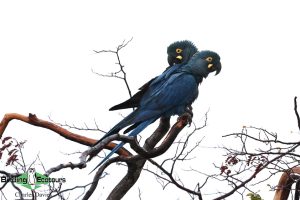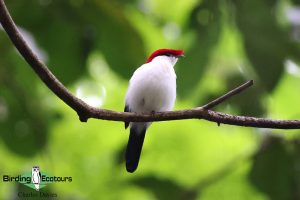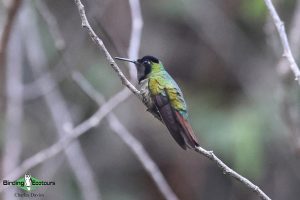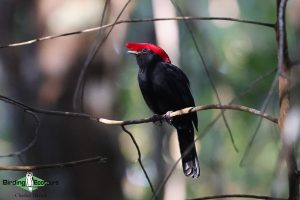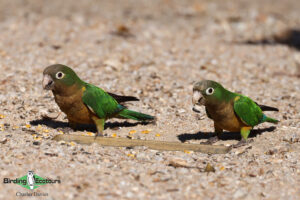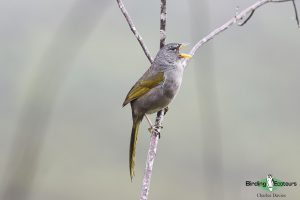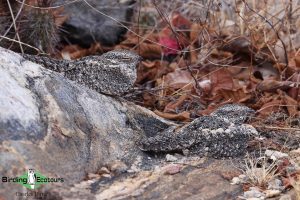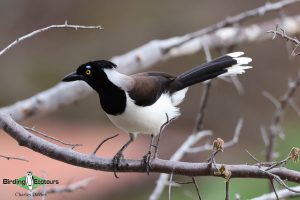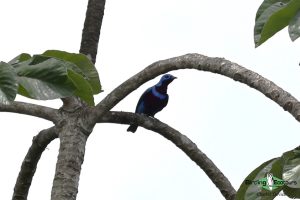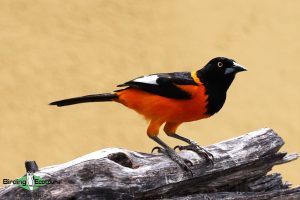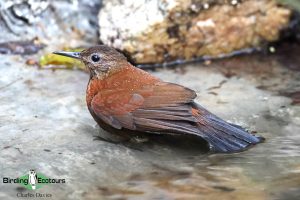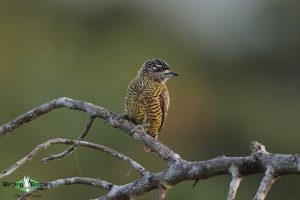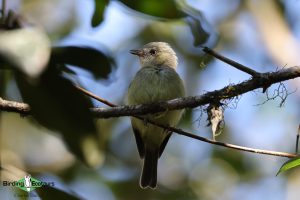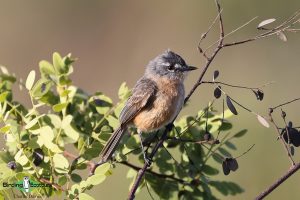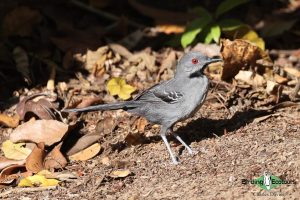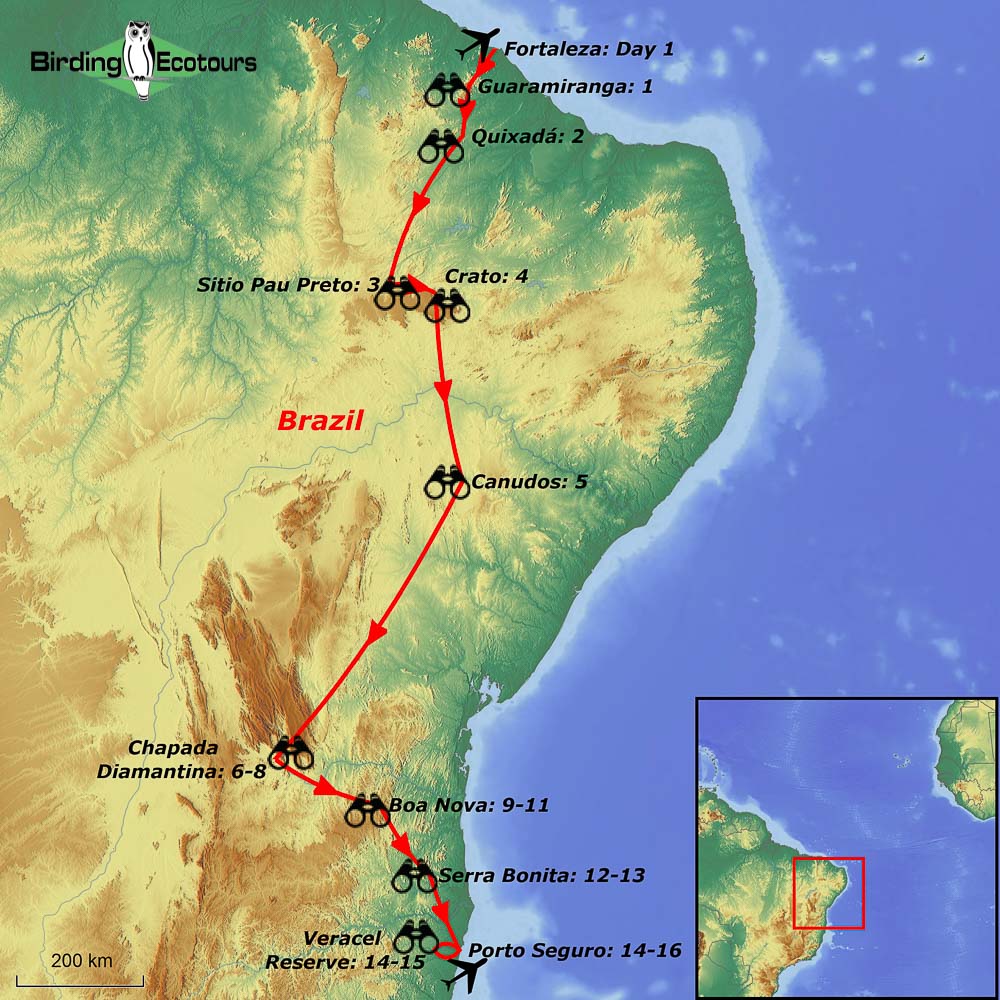DOWNLOAD TRIP REPORT
Birding Tour Northeastern Brazil: The Finest Brazilian Endemics
Northeastern Brazil Birding Tour: The Finest Brazilian Endemics
November 2026/2027
Our northeast Brazil birding tour is designed to explore a very remote corner of one of the largest countries on earth. This birding tour to Brazil is an epic adventure which covers 2,175 miles (3,500 kilometers) across the states of Ceará and Bahia in 16 days. We will be birding along a route which includes breath-taking scenery and many unique neotropical ecosystems. In the search for an incredible set of birds (including loads of endemics, range-restricted specials and some of the most threatened birds of South America) we will bird a wide range of ecosystems which will include the caatinga (dry scrub dominated by cacti), cerrado (Brazilian grasslands) and Atlantic Forest.
Araripe Manakin will be one of the main targets of our trip.
We will spend our 16-day Brazilian birding tour looking for sought-after species including the Critically Endangered (IUCN) and incredibly beautiful Araripe Manakin, which was only discovered in 1996, and the Endangered (IUCN) Lear’s Macaw. Other specials include avian jewels such as Great Xenops, Pink-legged Graveteiro, Banded and White-winged Cotingas, Grey-breasted Parakeet, White-browed Antpitta, Gould’s Toucanet, White-browed Guan, East Brazilian Chachalaca, Crescent-chested Puffbird, Diamantina Tapaculo, Slender Antbird, Giant Snipe, Sharpbill, Blue-winged Macaw, East Brazilian Pygmy Owl, Pygmy Nightjar, Ochre-backed Woodpecker, Ceara Gnateater and the spectacular Hooded Visorbearer.
Please do join us on this fantastic birding adventure to northeast Brazil which surely ranks as a must-do tour for anyone from the most demanding of world listers, to intrepid birders to macaw-lovers, alike.
Itinerary (16 days/15 nights)
Day 1. Arrival in Fortaleza and transfer to Guaramiranga
You will arrive at the Fortaleza Airport and be met by your Birding Ecotours leader and local representatives before being transferred by land to Guaramiranga (75 miles/120 kilometers). As we still have some birding scheduled for this afternoon, it is recommended that all participants arrive in Fortaleza before noon, or if this is not possible, we recommend arriving the previous day (we can book a hotel and transfer for you). Our 75-mile (120 kilometer) drive takes over two hours and will include a few birding stops en route. Some of these stops will involve roadside birding as well as a few short trails. Despite the busy day of birding we will ensure we arrive at Guaramiranga before dark. Some of the targets we expect to see on the first day include Grey-breasted Parakeet (one of the world’s most-threatened parrots) and other species of great interest such as Buff-breasted Tody-Tyrant, Ceara Gnateater, Ceara Woodcreeper, Ochraceous Piculet, Guianan Tyrannulet, Band-tailed Manakin, Gould’s Toucanet and Grey-headed Spinetail. We will pay special attention to some of the subspecies in the area (that could possibly be elevated to full species status) such as Variable Antshrike, Red-necked Tanager and Rufous-breasted Leaftosser.
Overnight: Sítio Guaramiranga, Guaramiranga
Day 2. Birding Guaramiranga and transfer to Quixadá
We will be transferred over land to Quixadá which will involve a drive of roughly 70 miles (110 kilometers) which normally takes around two hours to complete. Today we will target species such as White-naped Jay, Caatinga Parakeet, Pygmy Nightjar, Black-bellied Antwren, Pale Baywing, Caatinga Cacholote, Ochre-backed Woodpecker and, if we are lucky, we might even see the rare and endemic White-browed Guan; a flock of these large caatinga endemics usually comes to drink at a reservoir in the hotel area.
Overnight: Hotel Pedra dos Ventos, Quixadá
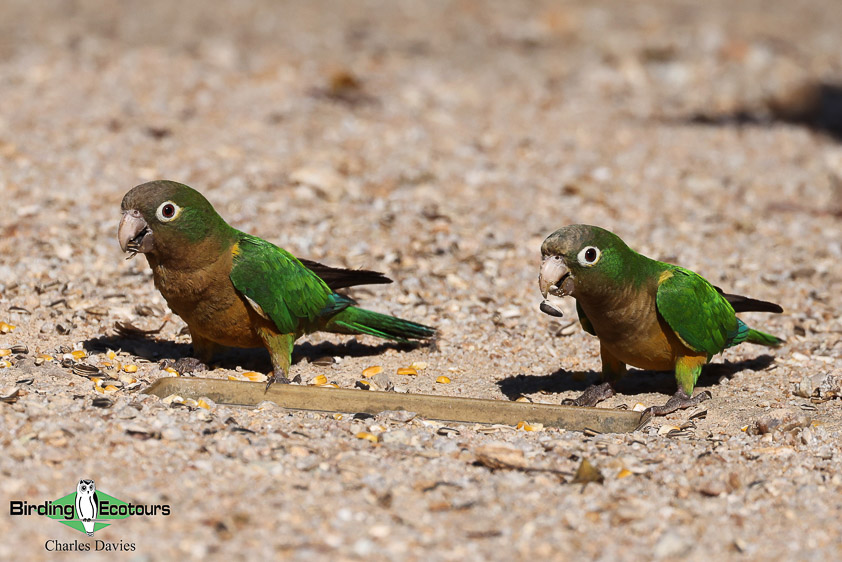
Day 3. Birding Quixadá and transfer to Potengi and Sitio Pau Preto area
Today, we travel to Potengi (219 miles/350 kilometers) which is a small town in the southern region of Ceará, part of the Chapada do Araripe area. Only recently has Potengi entered the world birding scene due to the efforts of a passionate birdwatcher and biologist who transformed his family property into a refuge for caatinga birds, the “Sítio Pau Preto”. We will stay in a small, family-owned lodge where we will feel right at home hosted by the biologist himself and his kind family. We will bird the area searching for many of the special birds of this unique habitat. For bird photographers, there are also feeders which attract a number of interesting species.
While here, caatinga specials will be the primary goal and should include the likes of White-browed Antpitta, Caatinga Antwren, White-throated Seedeater, Scarlet-throated Tanager, Great Xenops and Red-shouldered Spinetail. In addition to these species we will try to track down the local races of Lesser and Greater Wagtail-Tyrants and Stripe-backed Antbird. We will of course not forget the feeders, where we could see Campo Troupial, Red-cowled Cardinal, White-naped Jay and Pileated Finch. At the end of the day we have chances of seeing Least Nighthawks flying over the lodge.
Overnight: Pousada Sítio Pau Preto, Potengi. Laundry possible.
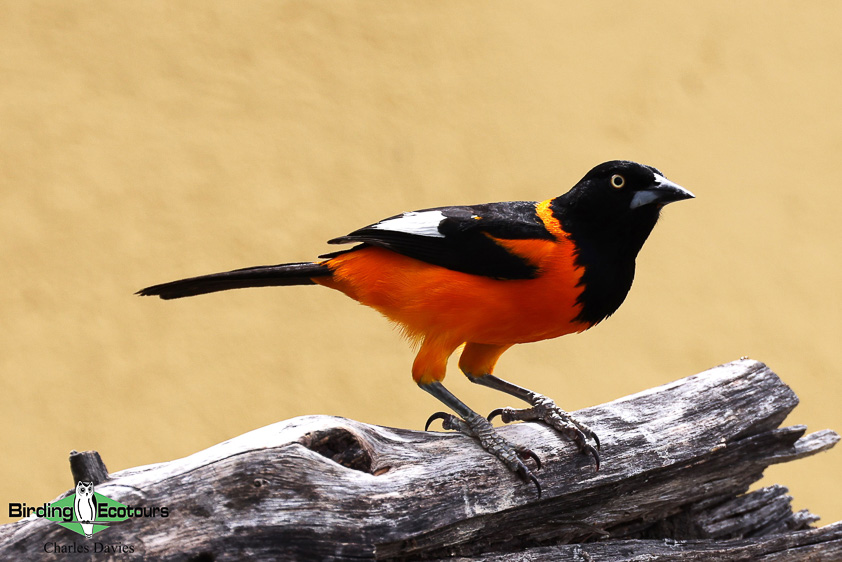
Day 4. Birding Arajara Water Park and transfer to Canudos
We have a two-hour drive to Crato where we will spend the morning birding in the Arajara Water Park which is situated in the foothills of the Chapada do Araripe plateau, an area we simply cannot miss, for it is the only site in the world for the superb Araripe Manakin! After enjoying the Araripe Manakin, we will be transferred to Canudos, in the state of Bahia. The drive is 236 miles (380 kilometers) long (roughly six hours). If we get there with time to spare, we could try for Blue-winged Macaws coming into roost, or rather explore the caatinga area near the lodge searching for any birds we may have missed the previous day.
Canudos has some of the most extraordinary scenes of the trip; the experience of hearing Lear’s Macaws calling with the red sand cliffs contrasting with the indigo blue of the macaws is simply unforgettable. We usually stay in a lodge inside the Lear’s Macaw Reserve, which many people love due to its laid-back atmosphere and tranquillity. We will also target Bat Falcon, King Vulture, Black-chested Buzzard-Eagle, Spotted Piculet, Stripe-breasted Starthroat and the endemic race of Blue-crowned Parakeet.
Overnight: Estação Biológica de Canudos, Canudos. No Wi-fi, no hot showers.
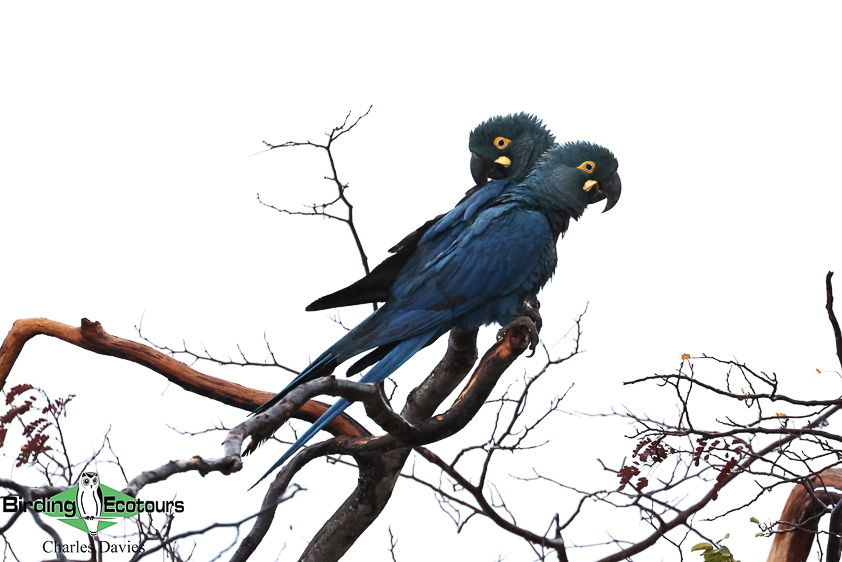
Day 5. Birding in Canudos and transfer to Chapada Diamantina
After some early morning birding around the lodge, we will start the long drive to Chapada Diamantina, a drive of over eight hours and covering 335 miles (540 kilometers). Here we will stay in the pleasant town of Lençois.
Overnight: Estalagem do Alcino, Lençois, Chapada Diamantina. Laundry possible.
Days 6 – 7. Chapada Diamantina
We will spend the next two days exploring the Chapada Diamantina area, which must certainly rank as one of the most impressive places in Brazil. With astonishing landscapes, Chapada Diamantina is part of a long series of highlands linked to the Espinhaço Mountain Range, which extends from north of Minas Gerais through to Bahia. There is a high diversity of habitats such as caatinga, cerrado, campo rupestre (arid mountain shrubs), humid and gallery forests and, of course, a high diversity of birds (almost 400 species). Most of these beautiful landscapes and pristine habitat are part of the Chapada Diamantina National Park, which protects 585 square miles (152,000 hectares). Our main targets are the striking Hooded Visorbearer, Sincora Antwren and Diamantina Tapaculo.
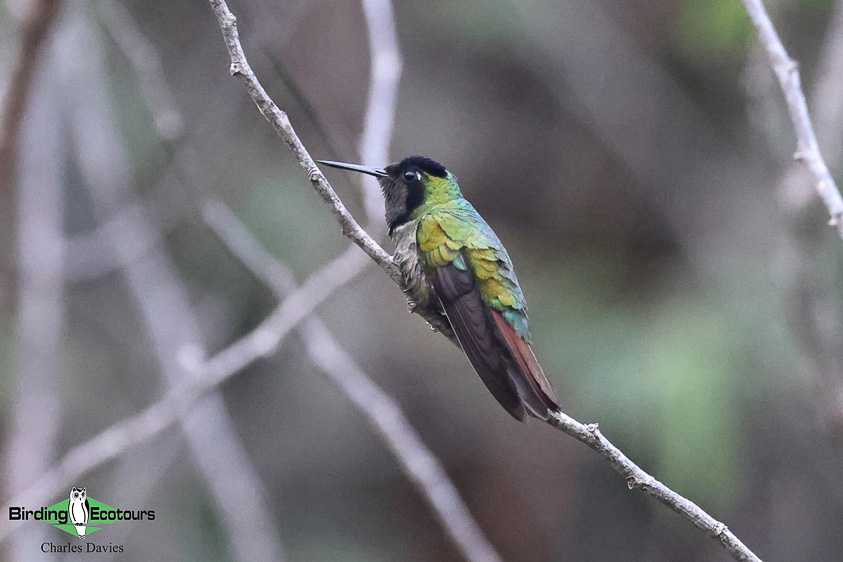
We have a long list of birds to look for besides the three mentioned above, including Collared Crescentchest, Helmeted Manakin, Pale-bellied Tyrant-Manakin, Surucua Trogon, Black-throated Saltator, Rufous Nightjar, Broad-tipped Hermit, Rufous-sided Pygmy Tyrant, Blue Finch, Shrike-like (White-banded) and Gilt-edged Tanagers, Rufous-winged Antshrike, East Brazilian Chachalaca, Copper Seedeater, Green-winged Saltator, Horned Sungem, Grey-backed Tachuri and Serra Finch.
Overnight Day 6: Estalagem do Alcino, Lençois, Chapada Diamantina. Laundry possible.
Overnight Day 7: Pousada Mucugê, Mucugê, Chapada Diamantina
Day 8. Birding Chapada Diamantina and transfer to Boa Nova
Today we have another long drive (281 miles/450 kilometers) to explore Boa Nova in the southwestern region of the Bahia state. Boa Nova is famous among birders due to its highly diverse bird community (more than 430 species recorded!), with typical elements of montane Atlantic Forest, the caatinga biome, and a unique transitional area between the Atlantic Forest and caatinga, known as “mata-de-cipó” (vine forest). We will spend the next three days exploring different sections of this vast area.
Many globally threatened species occur in the area which motivated the Brazilian government to create a mosaic of protected areas in the region – Boa Nova National Park and Boa Nova Wildlife Refuge, which protect 50 square miles (13,000 hectares) and 57 square miles (15,000 hectares), respectively. While here, we will look for Slender Antbird which is confined to the “mata-de-cipó” vegetation, where we could also find Narrow-billed Antwren and Hangnest Tody-Tyrant.
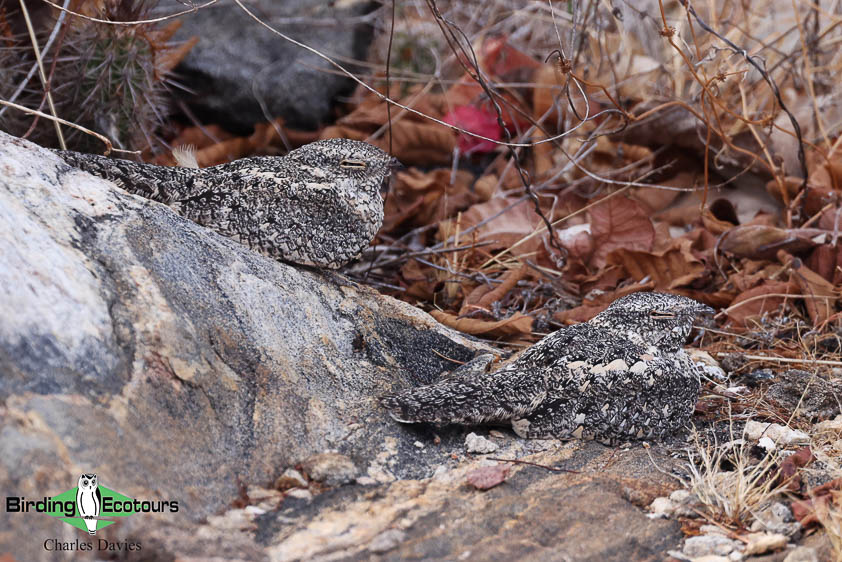
In the montane Atlantic Forest, we will search for species such as Striated Softtail, Bahia and Pallid Spinetails, Rio de Janeiro and Ferruginous Antbirds, Fork-tailed Tody-Tyrant, Crescent-chested Puffbird, Rufous-headed and Gilt-edged Tanagers, Black-billed Scythebill, East Brazilian Pygmy Owl, White-eyed Foliage-gleaner, Pin-tailed Manakin, Scale-throated Hermit, Spot-breasted Antvireo and Grey-hooded Attila. Here, we will also have chances of seeing the fantastic Giant Snipe. Hummingbird gardens can provide views of Sapphire-spangled Emerald, Swallow-tailed and Ruby-Topaz Hummingbirds, Planalto Hermit, Stripe-breasted Starthroat and several other delightful hummingbird species. The highlights in Poções include the rare Wied’s Tyrant-Manakin, White-bibbed Antbird, Greenish Schiffornis, Scaled Woodcreeper and Blue (Swallow-tailed) Manakin.
Overnight: Pousada do Sande, Boa Nova. Laundry possible.
Days 9 – 10. Birding Boa Nova
We will have two full days birding the Boa Nova area looking for many of the birds described above.
Overnight: Pousada do Sande, Boa Nova. Laundry possible.
Day 11. Transfer to Itacaré
Today we transfer from Boa Nova to Itacaré, coastal Bahia (125 miles/200 kilometers). This area has vast remnants of lowland forest, some protected in Serra do Conduru State Park and some on private land. Itacaré is a very popular area for tourists because of its lovely forests, waterfalls and beaches.
We plan to visit Maraú (north of Itacaré) in search of the rare, endemic Bahia Tapaculo, our main target. We also plan to head south of Itacaré to explore the Atlantic Forest of the Conduru State Park. This is one of the most diverse parts of the Atlantic Forest biome, with 458 tree species per hectare. Some of the birds we might see here include White-fronted Nunbird (the nominate subspecies), White-crowned, Blue-backed and Kinglet Manakins, Opal-rumped (Silver-breasted, if split) and Turquoise (White-bellied, if split) Tanagers, Great-billed Hermit (Margaretta’s, if split), Band-tailed Antwren, Scaled Antbird, Black-cheeked Gnateater, Cinereous-breasted Spinetail and many others.
Overnight: Pousada Vila dos Pássaros, Itacaré
Day 12. Transfer to Camacan (Serra Bonita Reserve), birding en route
Today, we drive another 125 miles (200 kilometers) to Serra Bonita. The Serra Bonita Reserve is an innovative, private conservation operation which was established to protect sub-montane forest in southern Bahia. This initiative was started thanks to the efforts of Vitor Becker and Clemira Souza who, after retirement, decided to dedicate their lives to the protection of this important and unique fragment of forest. Through the amalgamation of several rural property owners, the Serra Bonita Reserve now protects over 10 square miles (2,500 hectares) of fragile and pristine Brazilian Atlantic Forest. Additionally, this is also one of the last remnants of scrub montane forest in the region, which covers an area of about 30 square miles (7,500 hectares), ranging in altitude from 650 to 3,200 feet (200 to 1,000 meters), within the municipalities of Camacan and Pau Brasil, Bahia.
The main targets in the highlands are the unique Pink-legged Graveteiro, Bahia Tyrannulet, Plumbeous Antvireo, Salvadori’s Antwren, Sharpbill, Lemon-chested Greenlet, Crescent-chested Puffbird, the rare Atlantic race of Rufous-brown Solitaire (soon likely to be split), Blue (Swallow-tailed) Manakin, Spot-backed Antshrike, Spot-billed Toucanet, and Sombre Hummingbird. If we’re lucky enough to find a big mixed flock, we have chances of seeing the rare ‘Bahia Treehunter’ subspecies of Pale-browed Treehunter that is still awaiting a formal description. Birds we may see at the feeders include Maroon-bellied Parakeet, Red-necked, Green-headed, Golden-chevroned and Azure-shouldered Tanagers and sometimes even Spot-billed Toucanet. On the day we leave the reserve, we will spend some time birding in the lowlands where we will search for Kinglet Manakin, White-eared (Maroon-faced), Ochre-marked, and Golden-capped Parakeets, Black-necked Aracari, Thrush-like Wren, Yellow-rumped and Red-rumped Caciques, Chestnut-backed Antshrike, and Yellow-fronted Woodpecker. In recent years, we’ve often seen the beautiful and ultra-rare Banded Cotinga coming to feed on Açai Palm (ripe berries), near the headquarters of one of the properties in the lowlands – it’s all about being in the right place at the right time!
Overnight: Serra Bonita Reserve, Serra Bonita
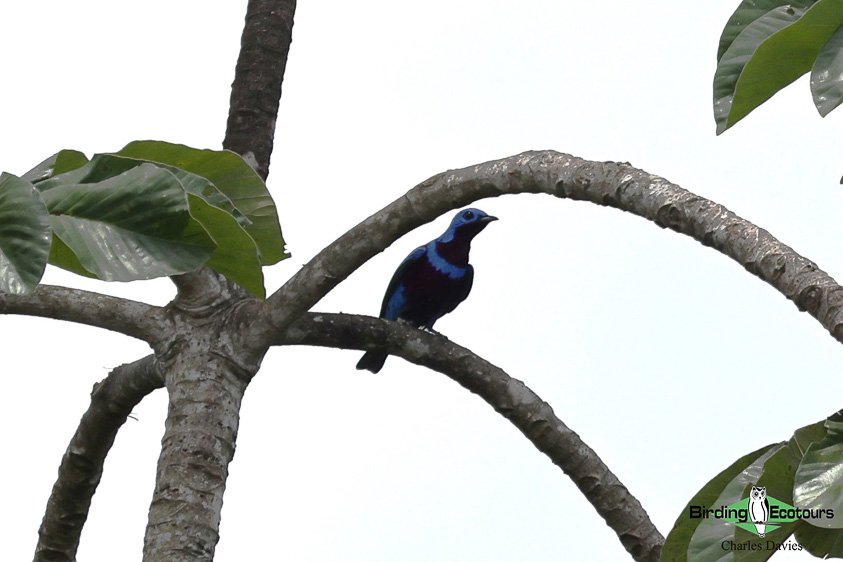
Day 13. Full day birding Serra Bonita Reserve
We will have a full day to explore Serra Bonita Reserve where we should find many of the species mentioned above.
Overnight: Serra Bonita Reserve, Serra Bonita
Days 14 – 15. Birding the Serra Bonita Reserve lowlands and transfer to Porto Seguro
Today is another 125 miles (200 kilometers) drive. One of the most famous beaches on the southern coast of Bahia, Porto Seguro is the third largest tourist destination in Brazil, so do not panic if there are many people out on the streets. The hustle and bustle of town will be left behind as we will be birding in Veracel Reserve, roughly 20 miles (32 kilometers) inland of Porto Seguro.
This private area protects almost 27 square miles (7,000 hectares) of a unique type of lowland Atlantic Forest known as “Mata de Tabuleiro”, which shares many elements (fauna and flora) with the Amazon Forest. At some sites in the forest, the calls of Screaming Pihas and huge towering trees will bring back fond memories of birding in the Amazon.
We will look for White-winged Cotinga, Hook-billed Hermit, Red-browed Amazon, Bahia Antwren, Band-tailed Antwren, Black-headed Berryeater, Ochre-marked Parakeet, Sooretama Slaty Antshrike, and there will be extra chances for Banded Cotinga and many more. There will be some night birding as well, where we will look for Black-capped Screech Owl, Tawny-browed Owl and, with a lot of luck, White-winged Potoo which is very rare in the Atlantic Forest. We will also bird the mangroves for specials such as Bicolored Conebill, Plain-bellied Emerald, Mangrove Rail and perhaps, Little Wood Rail.
Overnight: Best Western Shalimar Praia Hotel, Porto Seguro. Laundry possible.
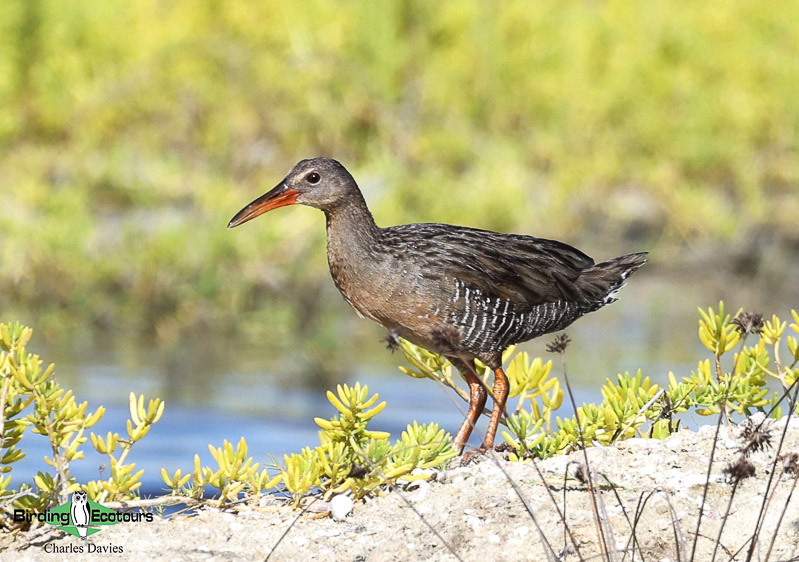
Day 16. Transfer to the Porto Seguro airport to connect with your flight
This is a travel day, perhaps with time for final birding depending on your departure flight times.
Please note that the itinerary cannot be guaranteed as it is only a rough guide and can be changed (usually slightly) due to factors such as availability of accommodation, updated information on the state of accommodation, roads, or birding sites, the discretion of the guides and other factors. In addition, we sometimes have to use a different international guide from the one advertised due to tour scheduling.
Download ItineraryNortheast Brazil: The Finest Brazilian Endemics, November 2023
Overview
What an incredible, highly successful tour of the north-eastern parts of Brazil. The transect from Fortaleza to Porto Seguro is just over 1,000 miles (1,700 km) “as the crow flies”, but we did a far higher mileage over the course of 16 days as we zigzagged from coast to coast through different habitats and endemic hotspots, ranging from coastal mangroves to arid caatinga to highland and lowland Atlantic Forest. Covering so much ground in just over two weeks could have been a tough trip, but in reality this was a moderate trip with excellent food, fairly comfortable accommodation and frequently a couple of hours’ rest during the heat of the day, while nevertheless doing well locating all our many avian targets. I don’t understand why this north-eastern chunk of Brazil is relatively “off the beaten track”, as it gives easy access to some of the world’s most beautiful, rare and localized bird species without having to “rough it”.
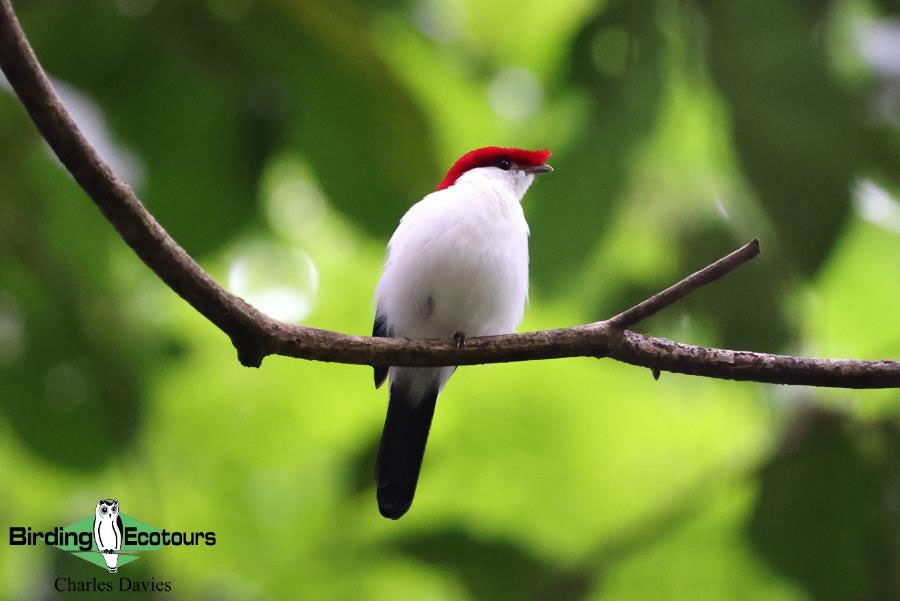
Araripe Manakin, a Critically Endangered, recently described, northeastern Brazil endemic.
We encountered many Brazilian endemics, a lot of them restricted to tiny parts of north-east Brazil. These included Araripe Manakin, Lear’s Macaw and other parrots, Banded Cotinga, Bahia Tapaculo, Diamantina Tapaculo, Sao Francisco Sparrow, an amazing suite of range-restricted and beautiful antbirds, many localized furnariids, Hooded Visorbearer, Great Xenops, Ceara Gnateater and a host of others too numerous to mention here. In addition to the localized species, this also proved a good trip for loads of Atlantic Forest endemics which also occur further south (e.g. into south-eastern Brazil and Paraguay), and more widespread South American birds which are, however, often tough to find, including Pinnated Bittern, Solitary Tinamou, Sharpbill, Blue Finch, Collared Cresentchest, Horned Sungem and several crakes and rails. We were delighted because we almost cleaned up on all possible targets, obtaining great views of most of them.

Lear’s Macaw!
Detailed Report
Day 1, 04th November 2023. Mangroves and coast at Icapuí
We arrived in Fortaleza yesterday and were ready to leave at 4 am this morning, the first official day of this magnificent tour of north-east Brazil. We left very early to ensure we arrived at the mangroves at Icapuí while the tide was still high enough to observe Little Wood-Rail easily. Indeed, shortly after arrival we saw three of them very nicely. A couple of Bicolored Conebill flew in close and we also saw a few Caatinga Parakeet. Not far from here, we then got great views of our next target, Mangrove Rail. There were good numbers of migrant shorebirds around, including Semipalmated and Least Sandpipers, Semipalmated Plover, Sanderling, Willet, Spotted Sandpiper, Hudsonian Whimbrel and others. A Caatinga Cacholote, a pair of dapper White Woodpecker, Common Ground Dove, Scaled Dove, the “white-bellied” form of Tropical Gnatcatcher, Straight-billed Woodcreeper and large numbers of Tropical Mockingbird were also around. We saw various egrets and herons, such as Little Blue Heron, and some gulls and terns, including Gull-billed Tern.
As we drove through the caatinga dry forest getting to and from this coastal mangrove area, we saw a lot of Red-cowled Cardinal and some gorgeously beautiful Campo Troupial.
After successful coastal birding, we headed inland to Guaramiranga, stopping for breakfast and some good birds along the way. These included Pearl Kite and Snail Kite.
We arrived at our beautiful, quaint accommodation in time for lunch. During lunch, we enjoyed close-up views of a pair of Masked Water Tyrant. Around our accommodation, we saw our first Pale-breasted Thrush, Blue-chinned Sapphire, (Southern) House Wren and several other birds.
In the afternoon, we headed to a spectacular birding spot, Refugio do Periquito Cara Suja. This is a refuge with nest boxes for the beautiful endemic Grey-breasted Parakeet. Here we also enjoyed close views of Cobalt-rumped Parrotlet. In addition, we had great success with some other star birds, including some endemics, e.g. Grey-headed Spinetail, Ceará Gnateater, Rufous-breasted Leaftosser (the subspecies that some authorities split into Ceará Gnateater),gorgeous Band-tailed Manakin,our first of many Ochre-lored Flatbill, Guianian Tyrannulet, Moustached Wren, Planalto Tyrannulet, Euler’s Flycatcher, Blue Dacnis, Ruby-topaz Hummingbird, two each of Short-tailed Hawk and Zone-tailed Hawk, stunning Caatinga Puffbird, Little Woodpecker and the endemic, stunning Ochre-backed Woodpecker. A female Great Antshrike, Flavescent Warbler, Golden-crowned Warbler, Buff-throated Woodcreeper (the ones here are sometimes split into Lafresnaye’s Woodcreeper), Pale-legged Hornero and several other good bird species were also around.
After dinner, a Spectacled Owl was seen and heard well in a pine tree right next to our accommodation. This was a great ending to a fabulous first day in which we saw most of the abovementioned species extremely well.
Day 2, 05th November 2023. Birding Icapuí to Quixadá
Some early morning birding around our lodge generated Pectoral Sparrow, beautiful Swallow-tailed Hummingbird, Band-tailed Hornero, Yellow-bellied Elaenia, Boat-billed Flycatcher, Variable Oriole and others.
As we navigated Guaramiranga en route to our next birding site, we saw several new trip birds. These included feral Common Waxbill, Large Elaenia, several each of the stunning Red-necked Tanager and Burnished-buff Tanager, Red-cowled Cardinal and Blue Dacnis.
We then headed into the mountains at Serra de Baturité, finding some star targets such as Gould’s Toucanet, Short-tailed Antthrush, Ochraceous Piculet, Rufous-breasted Hermit, Planalto Hermit, another Ceara Gnateater, Black-capped Antwren and others. Further along, we made another roadside stop where we added White-throated Spadebill, Ceara Woodcreeper and Variable Antshrike to our growing bird list.
Further along, we found Buff-breasted Tody-Tyrant, Rufous-tailed Jacamar and various others.
The habitat eventually became far more arid as we headed to Quixadá. In this otherwise very dry area, we stopped at some ponds which had Pied-billed Grebe, quite a number of Black-necked Stilt,large numbers of Ground Dove (mainly Ruddy but also smaller numbers of Plain-breasted and Picui), a couple of Fork-tailed Palm Swift flying around, Smooth-billed Ani, Caatinga Cacholote, White-headed Marsh Tyrant, Masked Water Tyrant, Chalk-browed Mockingbird, Screaming Cowbird (which only recently started occurring here), good numbers of Pale Baywing and Blue-black Grassquit.
Arriving at Hotel Pedra dos Ventos, we were in for a rewarding treat. Characterful and attractive White-naped Jay, close-up day-roosting Pygmy Nightjar and rather brazen White-browed Guan were in our faces, as was a Sayaca Tanager that sat on hotel guests’ heads and begged for food.
Our afternoon walk into the dry forest was particularly rewarding, providing close views of Golden-green Woodpecker, some more Ochraceous Piculet, a pair of Long-billed Wren, Barred Antshrike (the Caatinga subspecies that might get split), Barred Antshrike, Grey Pileated Finch, the diminutive Pearly-vented Tody-Tyrant, fly-by Caatinga Parakeet and Cobalt-rumped Parrotlet. A nearby pond contained various waterbirds, including a few Least Grebe and Brazilian Teal.
Final birding before dark (soon after 5 pm this far east in Brazil!), rewarded us with a Black-chested Buzzard-Eagle that at times “hung” stationary in the air, a close-up Boat-billed Flycatcher and various other birds.
Day 3, 06th November 2023. Birding Quixadá to Potengi
We started the day birding around the hotel again, finding a couple of new trip birds such as the strikingly-marked Black-bellied Antwren, White-tipped Dove, Rufous-browed Peppershrike and Variable Oriole. We also enjoyed great views of some star species we’d already seen, e.g. Ochre-backed Woodpecker, White-naped Jay, Caatinga Cacholote, White-browed Guan and other goodies.
After a wonderful breakfast and good coffee, we headed off in the direction of Potengi, making birding stops along the way. Our first stop allowed us to get our first really great views of Caatinga (Cactus) Parakeet.Another stop generated a cute pair of Burrowing Owl, a pair of Aplomado Falcon and some White-browed Blackbird (Meadowlark), a beautiful species with a dazzling red front. Further along we found a Limpkin and then at the next stop we saw a group of four Suiriri Flycatcher, a White Monjita, a couple of cartoon-like Guira Cuckoo and others.
Just before getting to our accommodation, we stopped to look at a strangely large flock of hundreds of Grassland Yellow Finch, and also managed to get good views of the endemic White-throated Seedeater, Southern Scrub Flycatcher, Sooty-fronted Spinetail, Greater Wagtail-Tyrant, Cobalt-rumped Parrotlet, etc.
We eventually arrived at the amazing Pousada Sitio Pau Preto, where bird feeders bring birds (and monkeys!) close-up. On arrival here, we were immediately greeted by several very confiding White-tufted-ear Marmoset (see the video below) and a great many brightly-colored birds, several of them Brazilian endemics. Luminous orange Campo Troupial, personality-filled and weird-sounding White-naped Jay, a great many Red-cowled Cardinal and Grey Pileated Finch, Swallow-tailed Hummingbird, close-up Lesser Yellow-headed Vulture with their multi-colored (not all yellow) heads, a Solitary (Black) Cacique,and others entertained us at close quarters. At one point, some female Scarlet-throated Tanager dropped in, sadly lacking the bright red throats. We saw this species a few times later in the tour but sadly never saw a male.
Walking a trail from the lodge allowed us to find some even better birds. These included the very attractive Stripe-backed Antbird, a Tataupa Tinamou that ran across the road in front of us, and two fabulously well-marked day-roosting Least Nighthawk (we also enjoyed watching a bunch of these nighthawk flying around at dusk, showing their bizarre flight mode).
Our final birding of the day was on another trail a short drive away from the lodge. This proved to be antbird paradise, with Black-bellied Antwren, Caatinga Antwren, Planalto Slaty Antshrike, Silvery-cheeked Antshrike and a female Great Antshrike all showing well. One of our main target birds, Red-shouldered Spinetail, gave us a nice show. Ochre-backed Woodpecker, a male Blue-crowned Trogon and a close-up Ultramarine Grosbeak brought bright color to an otherwise largely brown, arid landscape. A few Grey-eyed Greenlet showed well. At least four (probably more) Great Xenops proved a bit elusive, not giving the best views (unlike most other target species up until now) but we did get excellent views of this unusual bird a few days later. A magnificent Red-billed Scythebill also suddenly arrived. Flycatcher species abounded, including Fuscous Flycatcher, Brown-crested Flycatcher, Boat-billed Flycatcher, Southern Scrub Flycatcher, Southern Mouse-colored Tyrannulet, Common Tody-Flycatcher and Pearly-vented Tody-Tyrant. Charles almost stood on a tarantula.
At dusk, many Least Nighthawk came out, then we took the short drive back to our accommodation where we were serenaded by Ferruginous Pygmy Owl and Tropical Screech Owl while doing the list.
We then enjoyed a delicious supper and a surprise birthday cake for Caio. We retired to our rooms for some rest before the next day, one of the most important and exciting days of the trip!
Day 4, 07th November 2023. Araripe Manakin! And transfer to Canudos
We did some early morning birding around the lodge before breakfast. We then drove to the Arajara Water Park, initially making some stops at ponds along the way to look for good birds. New trip birds at these stops included Rufous-sided Crake (quite good views!), Purple Gallinule, White-cheeked Pintail, Fork-tailed Palm Swift, Black-backed Water Tyrant, Bahia Wagtail-Tyrant and others. We also saw a Brazilian Guinea-pig.
We then visited a site to look for White-browed Antpitta and, after some work, were richly rewarded with great views of this Brazilian endemic. At this same site, we also found a few other good new birds for the trip, such as Rufous-fronted Thornbird, Cinnamon Tanager, several Pale-bellied Tyrant-Manakin, and more.
After a while, we reached the Arajara Water Park at the base of the Chapada do Araripe Plateau. Here, our main target was ARARIPE MANAKIN, and we spent a couple of hours enjoying great sightings of this dazzling bird, quite easy to see when we were in its unbelievably small range. Araripe Manakin, although a very striking bird, was only discovered in 1998 and is classified as Critically Endangered by the IUCN; there are fewer than 1,000 of them in existence, all at a single site! The manakin supporting cast included Black-tailed Myiobius, Reddish Hermit and Planalto Hermit, amongst others.
We took a fairly long drive to our next site. Before reaching it, towards the end of the day, we went to a roost of beautiful Blue-winged Macaw, and also saw several other bird species like American Kestrel and a good mammal, Rock Cavi. We finally arrived at the remote and scenically picturesque Canudos Biological Station, where we were to spend the night. We excitedly anticipated the next morning, hoping for another very rare and localized endemic, yet another gorgeous-looking bird.
Day 5, 08th November 2023. Lear’s Macaw and transfer to Chapada Diamantina
In the early morning we drove to the Lear’s Macaw roost site, where these huge indigo parrots roost on beautiful red sandstone cliffs, a real sight to behold. The atmosphere here has to be experienced as it can’t be described in words. Large numbers of Lear’s Macaw, one of the planet’s most magnificent parrots, create a deafening racket as they fly to and from towering red sandstone cliffs. While enjoying the macaws we also saw other species, like Blue-crowned Parakeet, Turquoise-fronted Amazon, Cliff Flycatcher and more.
We then returned to our lodgings for a great breakfast and good coffee, finding Black-throated Saltator, Narrow-billed Woodcreeper, Lesser Eleania and other birds en route.
We then had the longest drive of the trip (about eight hours) to get to our base in the picturesque Chapada Diamantina, making brief stops for any good birds we saw along the way. These included Laughing Falcon, Pearl Kite, Crested Becard and Chestnut-vented Conebill.
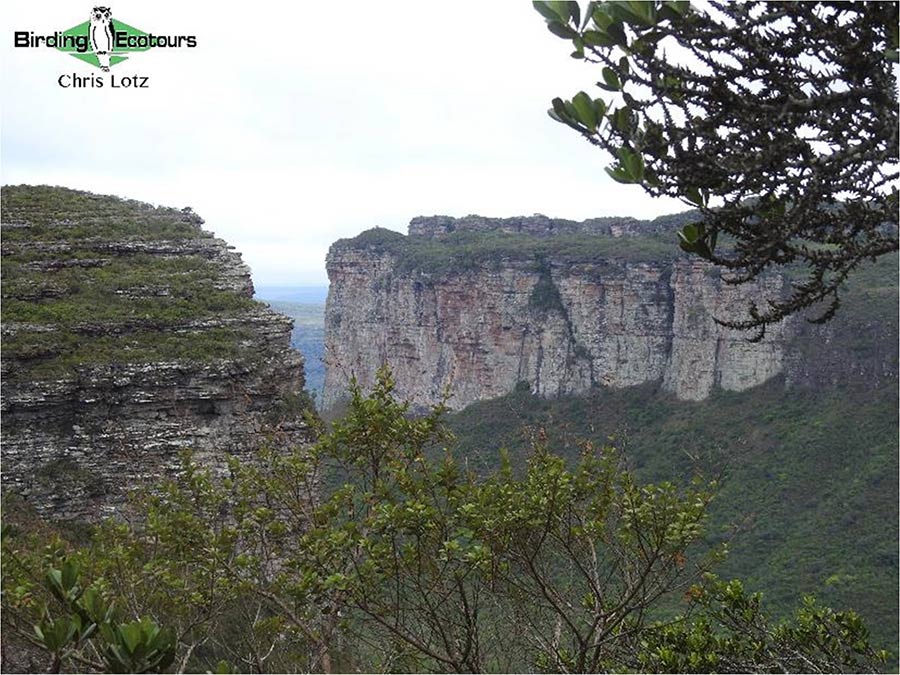
Chapada Diamantina scenery
Day 6, 09th November 2023. First full day at Chapada Diamantina
We enjoyed an early breakfast which was quite an experience, with a great variety of unusual and delicious breakfast items brought to us one by one. Then we headed to our first birding site up in the mountains. We had to work hard to find our target birds, but, one by one, we found three of them. These were Rufous-winged Antshrike, Sincora Antwren and Serra Finch. Only the guides saw Hooded Visorbearer, so we would have to try some more times for this beautiful hummingbird.
Other excellent birds that did show very well at our first birding site for the day (in addition to our major targets) were Gilt-edged Tanager, many Biscutate Swift (some of them low-flying), Fork-tailed Palm Swift, Pale-breasted Spinetail, Plain-crested Elaenia, Small-headed Elaenia, Variegated Flycatcher, Green-winged Saltator and many others.
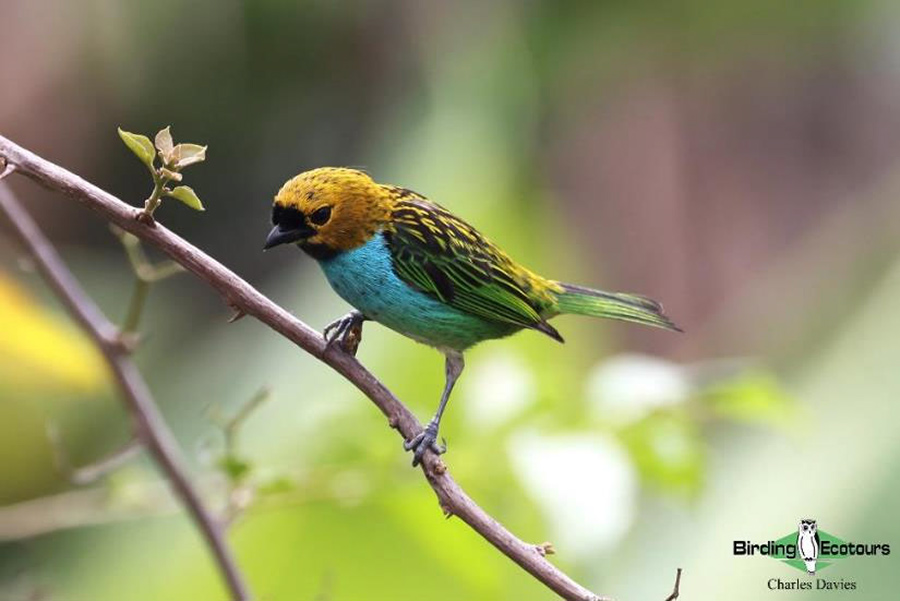
Gilt-edged Tanager, one of several beautiful tanager species we saw on this tour.
We then went up to the top of Pau Inacio Peak, enjoying a very different habitat and awe-inspiring views of the table mountains in the distance. This is often a good place for Hooded Visorbearer but we still could not find any. A number of other good birds were, however, around, the most notable being at least ten Velvety Black Tyrant, a close-up pair of beautiful Hepatic Tanager, a Planalto Hermit, good numbers of Chopi Blackbird and a really close-up Blue Dacnis. An American Kestrel and a Wood Stork flew over.
Instead of going to a restaurant for lunch, we opted for a light picnic lunch back at the early morning site for Hooded Visorbearer. Yet again, we failed to see one, although a White-vented Violetear put on a show.
Some of the best birding of the day was at our Pectoral Antwren stakeout, where one showed ridiculously close-up. We were also rewarded with amazingly good views of Spotted Piculet (a bird we’d been looking and listening for over the last few days, but without success), dazzling Guira Tanager, Burnished-buff Tanager and other beautiful tanagers, bright-plumaged Tropical Parula and more.
We spent the last hour or so of the day at our site for Helmeted Manakin, a close relative of Araripe Manakin, and our target showed really well, along with orange-bellied Surucua Trogon, White-bellied Seedeater and Yellow-bellied Seedeater.
Day 7, 10th November 2023. Second full day at Chapada Diamantina
We started the day with awesome views of Hooded Visorbearer very soon, putting an end to our previous failed attempts to see this species! At the same site, we also had great views of Rufous-tailed Jacamar and several other birds. A pair of Southern Yellowthroat showed well in the parking area.

We finally caught up with Hooded Visorbearer!
We then started heading towards Mucugê, enjoying picturesque scenery as we crossed a different part of Chapada Diamantina National Park. We made many birding stops en route, the first one at our Sao Francisco Sparrow site, getting remarkably good views of this highly range-restricted endemic. We were also pleased to find another of our targets, Broad-tipped Hermit. The area also had a lot of other good birds, including Bran-colored Flycatcher, Orange-headed Tanager, another flock of female Scarlet-throated Tanager,stunning Ultramarine Grosbeak and Greenish Elaenia. We enjoyed magnificent views of Great Xenops, unlike our relatively poor views earlier in the tour.
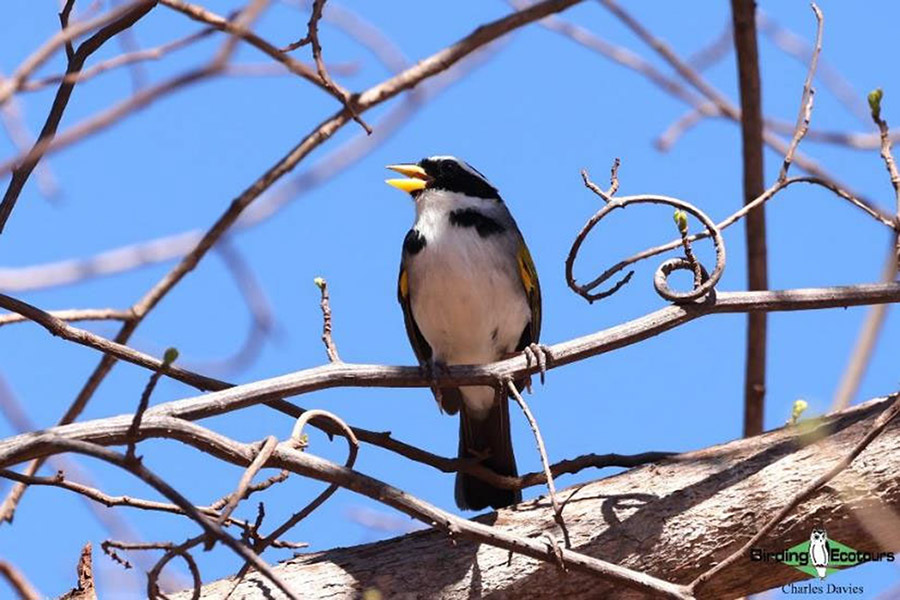
After a bit of patience, we enjoyed great views of Sao Francisco Sparrow.
As we progressed further, we found East Brazilian Chacalaca along the roadside a couple of times. Further along, we added yet more goodies to our growing list, including Rufous-sided Scrub Tyrant, Grassland Sparrow, Shrike-like Tanager, White-rumped Tanager, beautiful (Yellow-billed) Blue Finch and White-tailed Hawk. We then encountered a family of Burrowing Owl, including a baby one showing at the entrance to its burrow. A bit further, we added Chestnut-capped Blackbird to our list. At yet another stop, we found Copper Seedeater, Fork-tailed Flycatcher, some more female Scarlet-throated Tanager and a close-up Swallow-tailed Hummingbird. In a corn field, we found both Dubois’s and Yellow-bellied Seedeaters.
After checking into our hotel on the other side of Chapada Diamantina, we tried a couple of sites for Diamantina Tapaculo but without success (yet!). At our Horned Sungem site (also missed today but found later in the tour), we did enjoy a confiding pair of Rusty-backed Antwren, and what seemed like an old friend, Black-throated Saltator (which we had previously seen at Canudos).At the very end of the day, we had a remarkably productive session with some truly star birds. These included close-up Sharp-tailed Grass Tyrant and Collared Crescentchest, both wonderful species to find.
Day 8, 11th November 2023. Final Chapada Diamantina birding, then transfer to Boa Nova
This morning, we managed to clean up on the rest of our Chapada Diamantina targets, with remarkably good views of all of them. We started the day with Wedge-tailed Grass Finch,a pair of amazingly close Grey-backed Tachuri, a beautiful Aplomado Falcon and several other decent birds we’d already seen on previous days.
We then went to a dry forest site and were richly rewarded with wonderfully close views of a cooperative male Narrow-billed Antwren that showed very well a few times, and a more skulky female one. Hangnest Tody-Tyrant also showed very well. We enjoyed getting reacquainted with some great birds we’d already seen, such as Grey-headed Spinetail, Caatinga Parakeet (just outside the forest) and Southern Beardless Tyrannulet.
En route to our next destination (Boa Nova), we stopped at a hummingbird stakeout (mainly non-native Banksia flowers) and saw seven hummingbird species. The most abundant were Swallow-tailed Hummingbird and White-vented Violetear, both glistening brightly in the sun, such beautiful birds! A male Ruby-topaz Hummingbird, a male Glittering-bellied Emerald and a couple of absolutely tiny Amethyst Woodstar were also present. We were glad to see astunningly gorgeous male Horned Sungem, our main target. Although it kept us waiting for an hour, when it did arrive it came extremely close and gave magnificent in-flight and perched views several times. What a bird!
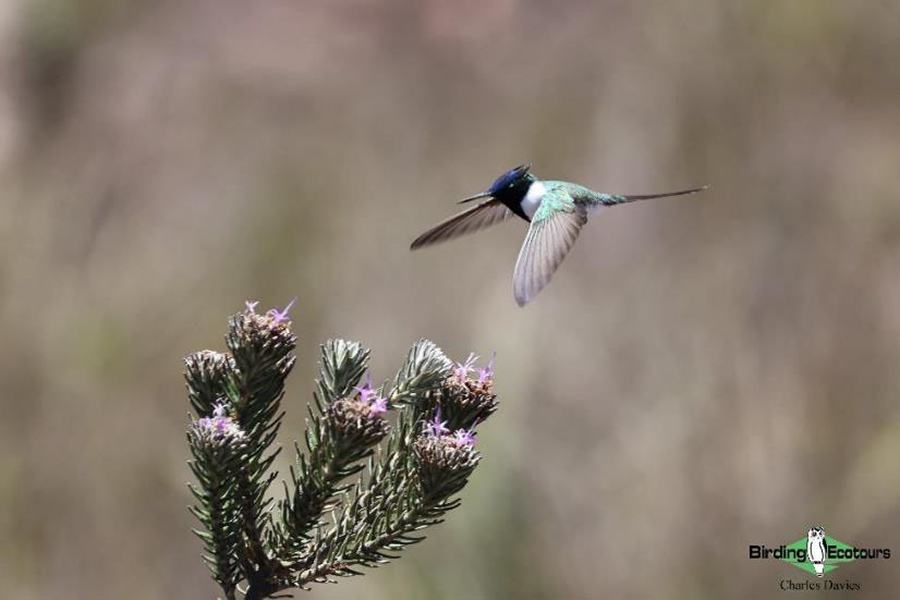
This inquisitive Horned Sungem inspected not only the flowers, but also us at one point.
A five minute drive then brought us to our Diamantina Tapaculo stakeout, and one showed alright (in typical tapaculo fashion, not brilliantly though). Three or four of them were around us, giving their strange call, but remaining hidden. We also enjoyed seeing Spix’s Spinetail here.
We then had an almost four hour drive to Boa Nova, where we would spend three nights, stopping for another delicious lunch to break the journey. Since we were ahead of schedule (bird target wise), not having missed anything yet and in fact having seen a couple of species earlier than expected, we had a couple of hours of down time before doing the bird list and enjoying dinner.
Day 9, 12th November 2023. First full day in Boa Nova
After a 5 am breakfast, we headed out for some arid area birding, stopping to try and refind a White-bellied Nothura that we flushedoff the road in front of us. We were unable to relocate the nothura but we did find Fulvous-crowned Scrub Tyrant and a few other species we’d already seen.
Stopping further along the road, we enjoyed views of a Crane Hawk, heard Laughing Falcon, and saw a couple of new hummingbirds for the trip (ones we would see much better this afternoon, so see below). The highlights, however, were two Slender Antbird and much better views of Black-bellied Antwren than what we’d had before. There were numerous other good birds around, although previously seen, so not listed here.
We then headed to the wet forest of Boa Nova National Park and had one of the best birding sessions of the trip so far, until lunch time. A Scale-throated Hermit sat patiently on a perch close to us until we’d had saturation views. A White-chinned Sapphire perched a bit further away but still gave good views. A male Green-backed Trogon sat facing us. Golden-spangled (Bahia) and Spotted Piculets, along with a pair of Red-stained Woodpecker, entertained us. Antbirds were again spectacular, new ones being Rio de Janeiro Antbird, Ferruginous Antbird, White-shouldered Fire-eye, Streak-capped Antwren, Rufous-margined Antwren, Cinereous Antshrike and Spot-breasted Antvireo; quite a haul. A Scaled Woodcreeper was a delight to encounter, as was a close-up Plain Xenops and an equally close-up Sharp-tailed Streamcreeper. Orange-eyed Thornbird and Striated Softtail also showed extremely well, with Pallid and Bahia Spinetails showing more briefly. A male Pin-tailed Manakin showed off and a Chestnut-crowned Becard kept giving us views. Whiskered Myiobius, Fork-tailed Tody-Tyrant, Ochre-lored Tody-Flycatcher, good numbers of Yellow-lored Tody-Flycatcher, Yellow-olive Flatbill, a pair of Yellow Tyrannulet, Rough-legged Tyrannulet and Southern Tropical Pewee all added to our already impressive flycatcher list (New World tyrant flycatchers are the world’s largest bird family). We had brief views of a Flame-crested Tanager and longer, but not brilliant, views high up of Rufous-headed Tanager.
We headed back to the hotel for another good lunch and a bit of a break before heading to a hummingbird garden, Lajedo dos beija-flores. This is a true bird paradise, with hummingbird and other feeders and plenty of plants to attract hummers and other species. We spent the whole afternoon here enjoying nine different hummingbird species, and many other birds too, from the comfort of chairs while drinking coffee. Hook-billed Hermit was the most localized hummer, but some of the most spectacular ones, with jewel-like colors glistening in the sunlight, were Ruby-topaz Hummingbird, Stripe-breasted Starthroat, Sapphire-spangled Emerald and Swallow-tailed Hummingbird.
Also in the hummingbird garden were a lot of close-up Caatinga Parakeet, Hangnest Tody-Tyrant, Violaceous Euphonia, dazzlingly bright Campo Troupial, Ultramarine Grosbeak, Black-throated Saltator, Green-winged Saltator and various others.
The antbird show was quite something, with the owners feeding them mealworms and thus bringing in some typically shy species, so we could see them close-up in the open. These included Slender Antbird, Silvery-cheeked Antbird and quite a number of others.
We ended an amazing day trying for Giant Snipe, but without success.
Day 10, 13th November 2023. Second full day using Boa Nova as a base
We headed to Serra do Arrepio, which provides an interesting habitat; a strange mix of Caatinga and Atlantic Forest. Including heard only species, we recorded over 80 species here in a couple of hours. We managed to see our most important targets by around 9 am. These were Wied’s Tyrant-Manakin, White-bibbed Antbird, Reiser’s Tyrannulet, Greenish Schiffornis, Rufous Gnateater and the spectacular Black-billed Scythebill. We also added some other new trip birds to our growing list, such as Plain Antvireo, Ochre-cheeked Spinetail, White-crested Tyrannulet, Grey-capped Tyrannulet, beautiful Long-tailed Tyrant and more.
On our walk down the hill, we saw two snakes in quick succession, green racer and a beautifully marked coral snake.
We then went to a nearby site for more targets, all of which we managed to find. We were very pleased to see the undescribed “Bahia” Treehunter, Ochre-rumped Antbird, the unique Sharpbill (in its own family), Bahia Tyrannulet and another Rufous Gnateater.
We then went to our Three-toed Jacamar site, finding three of them perched up, along with a perched Plumbeous Kite showing well, a pair of Rufous-headed Tanager and a Sooty Grassquit. A couple of Black Tufted Eared (Wied’s) Marmoset also provided some good entertainment.
We then drove to a small patch of forest where we found Scalloped Antbird and a pair of Silvery-flanked Antwren. This was bonus birding because we were ahead from a birding perspective.
Day 11, 14th November 2023. Transfer to Itacaré
We made some good birding stops during our 125 mile (200 km) drive to the touristy coastal town of Itacaré with its beautiful beaches and lowland forests. Our first stop along the way was at a small wetland where the highlights were two Pinnated Bittern (one of them close-up) and several Blackish Rail, among many other birds. At the next stop, we saw Ash-throated Crake and Yellow-fronted Woodpecker.
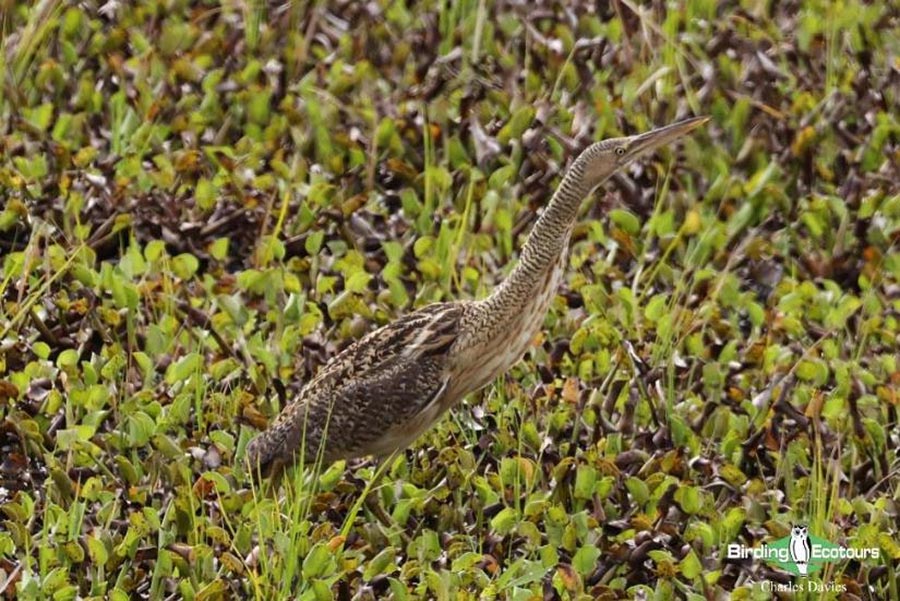
One of two Pinnated Bittern that showed well at the bird-filled pond we stopped at.
We then stopped at a restaurant with bird feeders for an early lunch, enjoying close-up views of Brazilian Tanager, the silver-breasted subspecies of Opal-rumped Tanager, Green-headed Tanager, Blue Dacnis, Green Honeycreeper and one of the most dazzlingly colorful birds on the planet, Red-legged Honeycreeper.
After checking into our hotel, we birded Conduru State Park, a coastal Atlantic Forest site. We obtained incredible views of Great-billed Hermit (Margaretta’s subspecies), East Brazilian Pygmy Owl, Green-backed Trogon, Swallow-winged Puffbird, Wedge-billed Woodcreeper, Buff-throated Woodcreeper, Straight-billed Woodcreeper, Blue-backed Manakin, Red-headed Manakin, a female White-crowned Manakin, Turquoise Tanager (the White-bellied subspecies) and others.
On the way back to our hotel, we enjoyed seeing some vocal Short-tailed Nighthawk.
Day 12, 15th November 2023. Birding en route to Serra Bonita
Our first new bird of the day was Peach-fronted Parakeet, one of several new parakeets we would see today. The others were Plain Parakeet, Ochre-marked Parakeet and White-eared Parakeet.
After enjoying prolonged views of a Crab-eating Fox in the road in front of us, we stopped at a spectacularly productive roadside site. This stop generated Black Jacobin hawking insects and putting on an aerial show, Sombre Hummingbird, three Sapphire hummingbirds in the form of Rufous-throated, White-chinned and Blue-chinned. A Golden-spanged Piculet showed really close-up for a long time, and a Southern White-fringed Antwren gave a rather quick but also close view. A Green-backed Becard showed well in great light for a little while. One of the highlights of this birding stop was a Smoky-fronted Tody-Flycatcher, yet another species that gave close views. White-lored Tyrannulet flitted around the canopy of a tree. Warbler-like Yellow-backed Tanager showed for a little while, and at one point a Dubois’s Seedeater sat right next to a Yellow-bellied Seedeater.
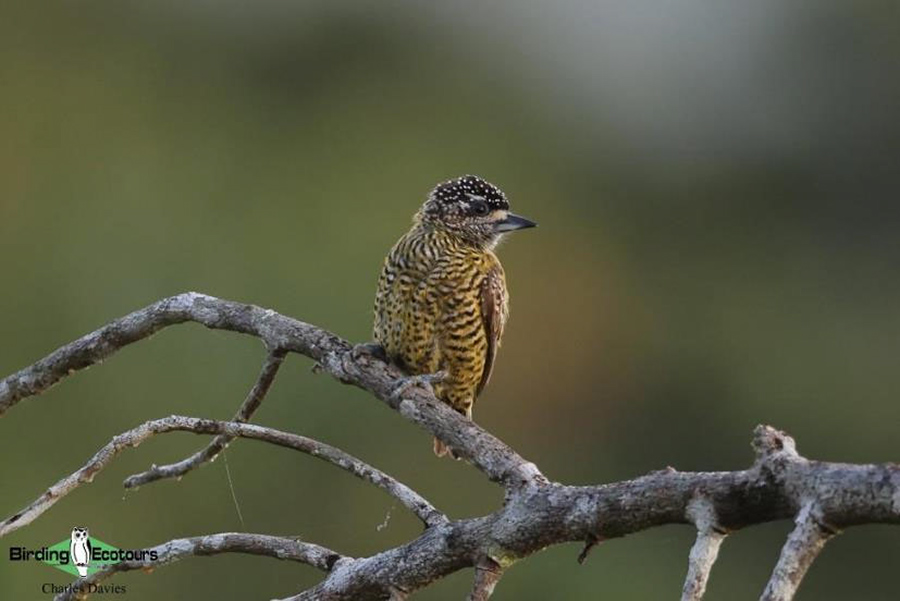
Golden-spangled Piculet.
We then walked a nearby trail for Bahia Tapaculo, a real skulker which took a couple of hours to find, initially with poor views. Later, a different individual rewarded us with awesome views.There were several other birds on the tapaculo trail, including Scaled Antbird, Kinglet Manakin, White-crowned Manakin, and low to the ground Brown-winged Schiffornis.
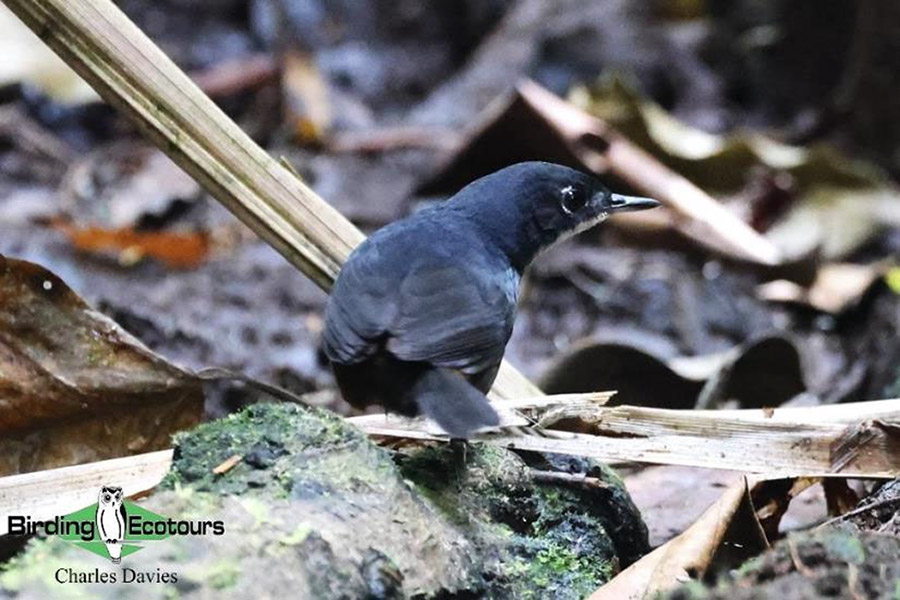
A nervous-looking Bahia Tapaculo showing its white throat.
After another excellent lunch (I must say we ate well, and drank excellent coffee, throughout this trip), we embarked on the journey up to the Serra Bonita Reserve, a private initiative protecting a chunk of submontane Atlantic Forest. We got here a little before dark, in time to see Rufous-brown Solitaire singing near our comfortable rooms.
Day 13, 16th November 2023. Full day birding Serra Bonita
We started the day with a 45 minute walk to breakfast; usually it would take a maximum of 15 minutes but there were plenty of great birds along the way to slow us down. Arguably the most spectacular was a pair of Spot-billed Toucanet that were at a feeder en route.
After an excellent breakfast, we headed to a higher elevation and did some roadside birding before heading onto a trail. A big surprise came in the form of a female Black-bellied Thorntail and there were also other hummingbirds around such as Sombre Hummingbird. A Black-throated Trogon, and later a Green-backed Trogon, showed well. Yellow-throated Woodpecker was seen well but briefly, because there were stacks of other birds all of a sudden and all at once (gotta love South American birding!) in a mixed flock which also included Salvadori’s Antwren. This was a fine day for antbirds and we also saw Spot-backed Antshrike (one high up and not showing its well-marked back much, and later one foraging low down that really gave us excellent views), Spot-breasted Antvireo, Plumbeous Antvireo, Streak-capped Antwren, Ferruginous Antbird and White-bibbed Antbird. It was also a fabulous morning for Foliage Gleaners, with White-collared, White-eyed and Black-capped in quick succession! Pale-browed Treehunter was also one of the many highlights. Plain-winged Woodcreeper and Lesser Woodcreeper were also new for the trip during this morning walk. Blue Manakin added a splash of bright color to the forest, unlike the nevertheless welcome Drab-breasted Bamboo Tyrant. Sharpbill were around in numbers, sometimes giving their strange vocalization, different here in the Atlantic Forest than elsewhere. Euler’s Flycatcher, Large-headed Flatbill, Grey-hooded Attila and our first, personality-filled Three-striped Flycatcher for the tour, all presented themselves. Lemon-chested Greenlet cooperated very well and we saw two new Thrushes for the tour, White-necked and Yellow-legged. We also saw our first Black-throated Grosbeak and many other birds.
After a tasty lunch, we sat at the bird feeders for a while, getting much better views of Black-throated Grosbeak anda plethora of dazzlingly colorful tanagers and euphonias including some new trip birds (please see the bird list at the end of this report).
In the afternoon, we went to some lookouts and were richly rewarded. We saw more than ten King Vulture, a Mantled Hawk, another surprise Black-bellied Thorntail and various other hummers. With great excitement, we also saw a couple of Atlantic Forest endemic Swallow-tailed Cotinga fly over us and land in a fruiting tree, but they unfortunately did not give very good views. This unusual bird is a specialty of south-east Brazil and is less common here, further north. Yet another Sharpbill was also around. Crescent-chested Puffbird eventually gave spectacular scope views after teasing us, as did a pair of Magpie Tanager. Several Golden-chevroned Tanager also joined the show.
After trying to get better views of Swallow-tailed Cotinga, we had to rush the birding at the end of the day as we started running out of light. We somehow managed to find a Variegated Antpitta in time, along with Ruddy Quail-Dove and White-throated Woodcreeper.
Day 14, 17th November 2023. Banded Cotinga and transfer to Porto Seguro
After some final birding in the forest-clad hills of Serra Bonita (seeing Yellow-green Grosbeak close-up, among other good species), we descended to the lowlands and went to our site for Banded Cotinga. We waited over three hours for this Critically Endangered beaut before one (a dazzling male) suddenly popped up and sat in full view in a cecropia and gave us great views. What a spectacularly beautiful bird! We did enjoy a few other great birds here while waiting for the cotinga, such as Black-necked Aracari, Lineated Woodpecker, Yellow-fronted Woodpecker, Buff-bellied Puffbird a close-up pair of Chestnut-backed Antshrike. There were also lots of Parakeets in the form of Ochre-marked, Maroon-bellied, White-eared and Golden-capped. A pair of Cliff Flycatcher showed extremely close-up and there were also many other nice species around.

Suddenly a male Banded Cotinga appeared!
After yet another delicious lunch, we headed for Porto Seguro. Just before reaching this coastal town, we stopped in at the Veracel reserve to do paperwork in preparation for an early start the next day, seeing a pair of the Reichenow’s subspecies (with their greyer heads) of Blue-headed Parrot sitting on top of a dead tree. Near our beach hotel in Porto Seguro, we found our main targets with ease. These were Plain-bellied Emerald and East Brazilian Chacalaca.
Day 15, 18th November 2023. Full day birding Veracel Reserve near Porto Seguro
We birded around the wonderful forest in this reserve the whole morning. Birding was unusually slow after so many amazing days, but we did find some great new birds for the trip. These included Sooretama Slaty Antshrike, Bahia Antwren, beautiful Rufous-capped Anthrush, tiny Eared Pygmy Tyrant, Hook-billed Kite and others. A female White-winged Cotinga only gave very brief views unfortunately, but little did we know just how well we’d see this bird (males and females) the next morning. After a slow birding morning, we went back to Porto Seguro for lunch and a “heat of the day” break.
Late afternoon and night birding was productive. It started with close-up views in excellent light of some hummingbirds, namely Reddish Hermit and Violet-capped Woodnymph. As dusk fell, we saw a Solitary Tinamou in the road in front of us, which then flew into its roost in a nearby tree!
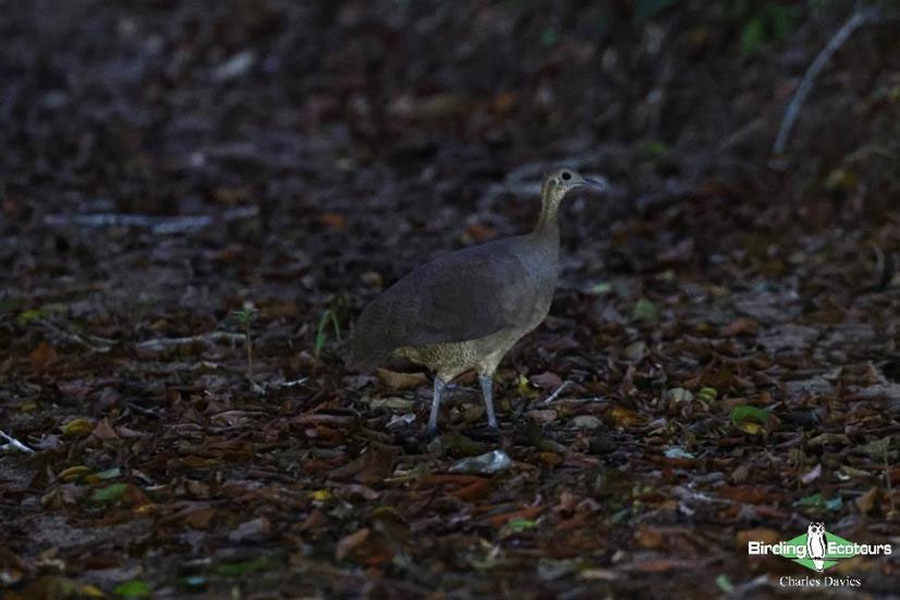
We got good views of this Solitary Tinamou before it flew into its roost tree.
We heard White-winged Potoobut sadly got no visuals, although we saw and heard a Common Potoo extremely well a bit later. The last bird of the evening was a quite confiding Black-capped Screech Owl at eye level, what a highlight! The moon and stars were spectacular tonight, and we also enjoyed a scope view of Jupiter with its two bands and four of its moons.
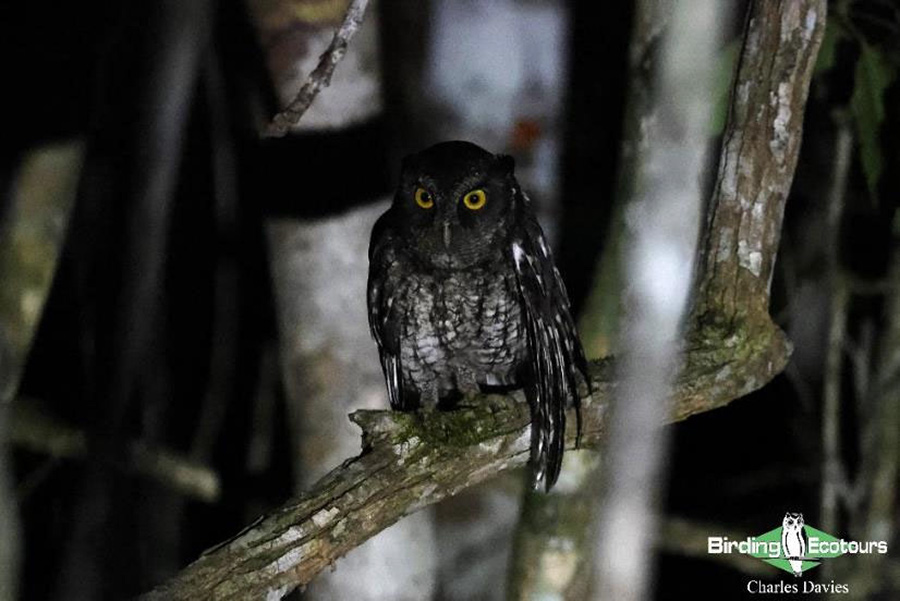
Black-capped Screech Owl!
Day 16, 19th November 2023. Final birding at Veracel Reserve and transfer to Porto Seguro airport for flights home
We started the day before it got light, trying to see White-winged Potoo again (at a different site) but we only heard it, although much closer than yesterday evening’s one. After a picnic breakfast with good coffee, we managed to see some Red-browed Amazon and the more widespread Orange-winged Amazon,along with other species we’d seen on previous days.
We then drove to a nearby site still within Veracel Reserve and enjoyed some spectacular target species in the form of several male and female White-winged Cotinga, Bare-throated Bellbird and Black-headed Berryeater, awesome views of all three!
We then walked another trail for about a mile, finding a couple more new trip birds to end this wonderful tour. The new species were Grey-crowned Flatbill, a flatbill of the high canopy and a pair of stunning Ringed Woodpecker. We eventually headed back to Porto Seguro for lunch and to freshen up and rest before our flights home.
What a tour!
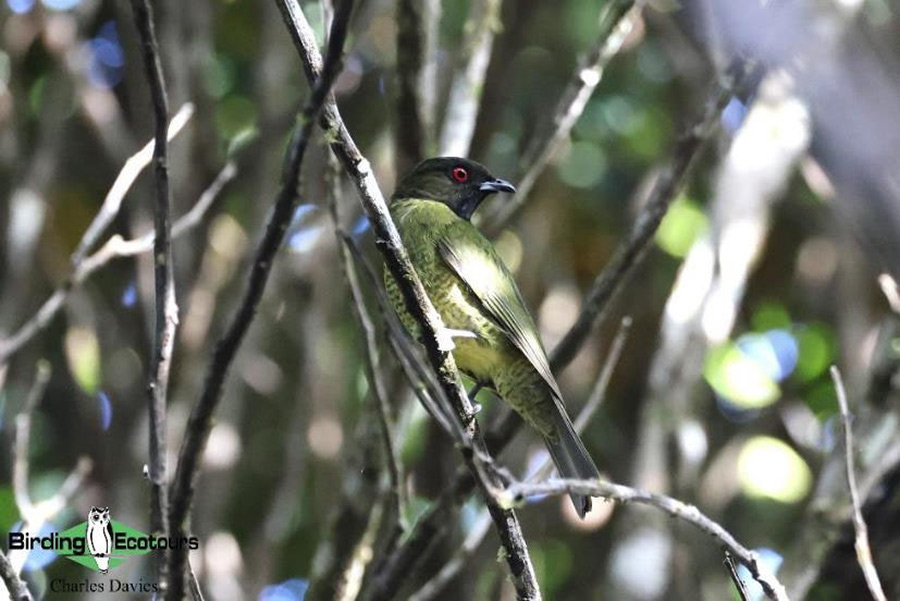
Black-headed Berryeater.
Please see the e-bird trip report at Northeast Brazil 2023 – eBird Trip Report.
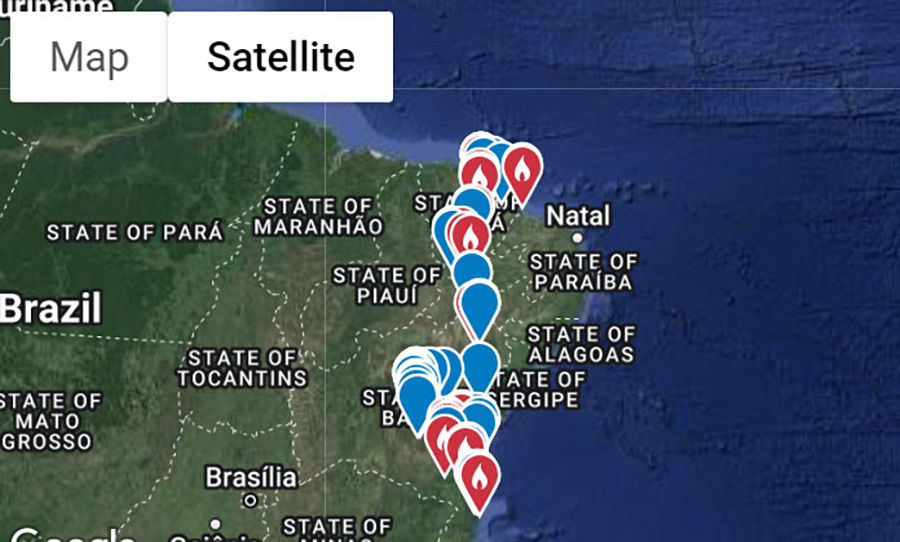
eBird map showing our sightings on this tour.
Bird List – Following IOC (13.2)
Birds ‘heard only’ are marked with (H) after the common name, all other species were seen. The following notation after species names is used to show conservation status following BirdLife International: CR = Critically Endangered, EN = Endangered, VU = Vulnerable.
| Common name | Scientific name |
| Tinamous (Tinamidae) | |
| Solitary Tinamou | Tinamus solitarius |
| Little Tinamou (H) | Crypturellus soui |
| Brown Tinamou (H) | Crypturellus obsoletus |
| Yellow-legged Tinamou (Endemic) (H) | Crypturellus noctivagus |
| Variegated Tinamou (H) | Crypturellus variegatus |
| Small-billed Tinamou (H) | Crypturellus parvirostris |
| Tataupa Tinamou | Crypturellus tataupa |
| Red-winged Tinamou (H) | Rhynchotus rufescens |
| White-bellied Nothura | Nothura boraquira |
| Ducks, Geese, Swans (Anatidae) | |
| White-faced Whistling Duck | Dendrocygna viduata |
| Brazilian Teal | Amazonetta brasiliensis |
| White-cheeked Pintail | Anas bahamensis |
| Chachalacas, Curassows, Guans (Cracidae) | |
| East Brazilian Chachalaca (Endemic) | Ortalis araucuan |
| White-browed Guan (Endemic) – VU | Penelope jacucaca |
| Nightjars (Caprimulgidae) | |
| Least Nighthawk | Chordeiles pusillus |
| Short-tailed Nighthawk | Lurocalis semitorquatus |
| Pygmy Nightjar (Endemic) | Nyctipolus hirundinaceus |
| Pauraque | Nyctidromus albicollis |
| Ocellated Poorwill (H) | Nyctiphrynus ocellatus |
| Potoos (Nyctibiidae) | |
| Common Potoo | Nyctibius griseus |
| White-winged Potoo (H) | Nyctibius leucopterus |
| Swifts (Apodidae) | |
| Biscutate Swift | Streptoprocne biscutata |
| Grey-rumped Swift | Chaetura cinereiventris |
| Fork-tailed Palm Swift | Tachornis squamata |
| Hummingbirds (Trochilidae) | |
| Black Jacobin | Florisuga fusca |
| Hook-billed Hermit (Endemic) – VU | Glaucis dohrnii |
| Rufous-breasted Hermit | Glaucis hirsutus |
| Broad-tipped Hermit (Endemic) | Anopetia gounellei |
| Reddish Hermit | Phaethornis ruber |
| Planalto Hermit | Phaethornis pretrei |
| Scale-throated Hermit | Phaethornis eurynome |
| Great-billed Hermit | Phaethornis malaris |
| Hooded Visorbearer (Endemic) | Augastes lumachella |
| White-vented Violetear | Colibri serrirostris |
| Horned Sungem | Heliactin bilophus |
| Ruby-topaz Hummingbird | Chrysolampis mosquitus |
| Black-throated Mango | Anthracothorax nigricollis |
| Black-bellied Thorntail | Discosura langsdorffi |
| Stripe-breasted Starthroat (Endemic) | Heliomaster squamosus |
| Amethyst Woodstar | Calliphlox amethystina |
| Glittering-bellied Emerald | Chlorostilbon lucidus |
| Fork-tailed Woodnymph | Thalurania furcata |
| Violet-capped Woodnymph | Thalurania glaucopis |
| Swallow-tailed Hummingbird | Eupetomena macroura |
| Sombre Hummingbird (Endemic) | Eupetomena cirrochloris |
| Versicolored Emerald | Chrysuronia versicolor |
| Plain-bellied Emerald | Chrysuronia leucogaster |
| Glittering-throated Emerald | Chionomesa fimbriata |
| Sapphire-spangled Emerald | Chionomesa lactea |
| Rufous-throated Sapphire | Hylocharis sapphirina |
| White-chinned Sapphire | Chlorestes cyanus |
| Blue-chinned Sapphire | Chlorestes notata |
| Cuckoos (Cuculidae) | |
| Guira Cuckoo | Guira guira |
| Smooth-billed Ani | Crotophaga ani |
| Striped Cuckoo | Tapera naevia |
| Squirrel Cuckoo | Piaya cayana |
| Pigeons, Doves (Columbidae) | |
| Rock Dove | Columba livia |
| Scaled Pigeon | Patagioenas speciosa |
| Picazuro Pigeon | Patagioenas picazuro |
| Pale-vented Pigeon | Patagioenas cayennensis |
| Plumbeous Pigeon | Patagioenas plumbea |
| Scaled Dove | Columbina squammata |
| Common Ground Dove | Columbina passerina |
| Plain-breasted Ground Dove | Columbina minuta |
| Ruddy Ground Dove | Columbina talpacoti |
| Picui Ground Dove | Columbina picui |
| Blue Ground Dove | Claravis pretiosa |
| Ruddy Quail-Dove | Geotrygon montana |
| White-tipped Dove | Leptotila verreauxi |
| Eared Dove | Zenaida auriculata |
| Rails, Crakes & Coots (Rallidae) | |
| Ash-throated Crake | Mustelirallus albicollis |
| Blackish Rail | Pardirallus nigricans |
| Little Wood Rail (Endemic) | Aramides mangle |
| Grey-cowled Wood Rail | Aramides cajaneus |
| Mangrove Rail | Rallus longirostris |
| Common Gallinule | Gallinula galeata |
| Purple Gallinule | Porphyrio martinica |
| Russet-crowned Crake (H) | Rufirallus viridis |
| Rufous-sided Crake | Laterallus melanophaius |
| Limpkin (Aramidae) | |
| Limpkin | Aramus guarauna |
| Grebes (Podicipedidae) | |
| Least Grebe | Tachybaptus dominicus |
| Pied-billed Grebe | Podilymbus podiceps |
| Stilts, Avocets (Recurvirostridae) | |
| Black-necked Stilt | Himantopus mexicanus |
| Plovers (Charadriidae) | |
| Southern Lapwing | Vanellus chilensis |
| Semipalmated Plover | Charadrius semipalmatus |
| Jacanas (Jacanidae) | |
| Wattled Jacana | Jacana jacana |
| Sandpipers, Snipes (Scolopacidae) | |
| Hudsonian Whimbrel | Numenius hudsonicus |
| Turnstone | Arenaria interpres |
| Sanderling | Calidris alba |
| Least Sandpiper | Calidris minutilla |
| Semipalmated Sandpiper | Calidris pusilla |
| Spotted Sandpiper | Actitis macularius |
| Lesser Yellowlegs | Tringa flavipes |
| Willet | Tringa semipalmata |
| Gulls, Terns, Skimmers (Laridae) | |
| Grey-headed Gull | Chroicocephalus cirrocephalus |
| Laughing Gull | Leucophaeus atricilla |
| Gull-billed Tern | Gelochelidon nilotica |
| Storks (Ciconiidae) | |
| Wood Stork | Mycteria americana |
| Cormorants, Shags (Phalacrocoracidae) | |
| Neotropic Cormorant | Nannopterum brasilianum |
| Herons, Bitterns (Ardeidae) | |
| Rufescent Tiger Heron | Tigrisoma lineatum |
| Pinnated Bittern | Botaurus pinnatus |
| Night-heron | Nycticorax nycticorax |
| Striated Heron | Butorides striata |
| Cattle Egret | Bubulcus ibis |
| Cocoi Heron | Ardea cocoi |
| Great White Egret | Ardea alba |
| Little Blue Heron | Egretta caerulea |
| Snowy Egret | Egretta thula |
| New World Vultures (Cathartidae) | |
| King Vulture | Sarcoramphus papa |
| Black Vulture | Coragyps atratus |
| Turkey Vulture | Cathartes aura |
| Lesser Yellow-headed Vulture | Cathartes burrovianus |
| Kites, Hawks, Eagles (Accipitridae) | |
| Pearl Kite | Gampsonyx swainsonii |
| Hook-billed Kite | Chondrohierax uncinatus |
| Swallow-tailed Kite (H) | Elanoides forficatus |
| Plumbeous Kite | Ictinia plumbea |
| Snail Kite | Rostrhamus sociabilis |
| Crane Hawk | Geranospiza caerulescens |
| Savanna Hawk | Buteogallus meridionalis |
| Roadside Hawk | Rupornis magnirostris |
| White-tailed Hawk | Geranoaetus albicaudatus |
| Black-chested Buzzard-Eagle | Geranoaetus melanoleucus |
| Mantled Hawk (Endemic) | Pseudastur polionotus |
| Short-tailed Hawk | Buteo brachyurus |
| Zone-tailed Hawk | Buteo albonotatus |
| Owls (Strigidae) | |
| Burrowing Owl | Athene cunicularia |
| East Brazilian Pygmy Owl | Glaucidium minutissimum |
| Ferruginous Pygmy Owl | Glaucidium brasilianum |
| Tropical Screech Owl | Megascops choliba |
| Spectacled Owl | Pulsatrix perspicillata |
| Trogons (Trogonidae) | |
| Green-backed Trogon | Trogon viridis |
| Blue-crowned Trogon | Trogon curucui |
| Surucua Trogon | Trogon surrucura |
| Black-throated Trogon | Trogon rufus |
| Kingfishers (Alcedinidae) | |
| Amazon Kingfisher | Chloroceryle amazona |
| Ringed Kingfisher | Megaceryle torquata |
| Jacamars (Galbulidae) | |
| Three-toed Jacamar (Endemic) | Jacamaralcyon tridactyla |
| Rufous-tailed Jacamar | Galbula ruficauda |
| Puffbirds (Bucconidae) | |
| Caatinga Puffbird (Endemic) | Nystalus maculatus |
| Crescent-chested Puffbird (Endemic) | Malacoptila striata |
| Toucans (Ramphastidae) | |
| Black-necked Aracari | Pteroglossus aracari |
| Gould’s Toucanet | Selenidera gouldii |
| Spot-billed Toucanet | Selenidera maculirostris |
| Channel-billed Toucan | Ramphastos vitellinus |
| Woodpeckers (Picidae) | |
| Golden-spangled Piculet | Picumnus exilis |
| Spotted Piculet (Endemic) | Picumnus pygmaeus |
| White-barred Piculet | Picumnus cirratus |
| Ochraceous Piculet (Endemic) | Picumnus limae |
| White Woodpecker | Melanerpes candidus |
| Little Woodpecker | Veniliornis passerinus |
| Red-stained Woodpecker | Veniliornis affinis |
| Yellow-throated Woodpecker | Piculus flavigula |
| Golden-green Woodpecker | Piculus chrysochloros |
| Green-barred Woodpecker | Colaptes melanochloros |
| Campo Flicker | Colaptes campestris |
| Ochre-backed Woodpecker (Endemic) | Celeus ochraceus |
| Ringed Woodpecker | Celeus torquatus |
| Lineated Woodpecker | Dryocopus lineatus |
| Caracaras, Falcons (Falconidae) | |
| Crested Caracara | Caracara plancus |
| Yellow-headed Caracara | Milvago chimachima |
| Laughing Falcon | Herpetotheres cachinnans |
| American Kestrel | Falco sparverius |
| Aplomado Falcon | Falco femoralis |
| African & New World Parrots (Psittacidae) | |
| Brown-backed Parrotlet (Endemic) (H) | Touit melanonotus |
| Golden-tailed Parrotlet (Endemic) – VU (H) | Touit surdus |
| Plain Parakeet (Endemic) | Brotogeris tirica |
| Yellow-chevroned Parakeet | Brotogeris chiriri |
| Scaly-headed Parrot | Pionus maximiliani |
| Blue-headed Parrot | Pionus menstruus |
| Red-browed Amazon (Endemic) – VU | Amazona rhodocorytha |
| Turquoise-fronted Amazon | Amazona aestiva |
| Orange-winged Amazon | Amazona amazonica |
| Cobalt-rumped Parrotlet | Forpus xanthopterygius |
| Ochre-marked Parakeet (Endemic) – VU | Pyrrhura cruentata |
| Maroon-bellied Parakeet | Pyrrhura frontalis |
| Grey-breasted Parakeet (Endemic) – EN | Pyrrhura griseipectus |
| White-eared Parakeet (Endemic) – VU | Pyrrhura leucotis |
| Lear’s Macaw (Endemic) – EN | Anodorhynchus leari |
| Peach-fronted Parakeet | Eupsittula aurea |
| Caatinga Parakeet (Endemic) | Eupsittula cactorum |
| Golden-capped Parakeet (Endemic) | Aratinga auricapillus |
| Blue-winged Macaw | Primolius maracana |
| Blue-crowned Parakeet | Thectocercus acuticaudatus |
| Ovenbirds (Furnariidae) | |
| Rufous-breasted Leaftosser | Sclerurus scansor |
| Olivaceous Woodcreeper | Sittasomus griseicapillus |
| Plain-winged Woodcreeper | Dendrocincla turdina |
| Wedge-billed Woodcreeper | Glyphorynchus spirurus |
| White-throated Woodcreeper | Xiphocolaptes albicollis |
| Lesser Woodcreeper | Xiphorhynchus fuscus |
| Ceara Woodcreeper (Endemic) – VU | Xiphorhynchus atlanticus |
| Buff-throated Woodcreeper | Xiphorhynchus guttatus |
| Straight-billed Woodcreeper | Dendroplex picus |
| Red-billed Scythebill | Campylorhamphus trochilirostris |
| Black-billed Scythebill | Campylorhamphus falcularius |
| Narrow-billed Woodcreeper | Lepidocolaptes angustirostris |
| Scaled Woodcreeper (Endemic) | Lepidocolaptes squamatus |
| Plain Xenops | Xenops genibarbis |
| Streaked Xenops | Xenops rutilans |
| Band-tailed Hornero (Endemic) | Furnarius figulus |
| Pale-legged Hornero | Furnarius leucopus |
| Rufous Hornero | Furnarius rufus |
| Sharp-tailed Streamcreeper | Lochmias nematura |
| White-collared Foliage-gleaner (Endemic) | Anabazenops fuscus |
| Great Xenops (Endemic) | Megaxenops parnaguae |
| Pale-browed Treehunter (Endemic) | Cichlocolaptes leucophrus |
| Bahia Treehunter (undescribed) (Endemic) – UN | Heliobletus sp. nov. |
| Black-capped Foliage-gleaner | Philydor atricapillus |
| White-eyed Foliage-gleaner | Automolus leucophthalmus |
| Rufous-fronted Thornbird | Phacellodomus rufifrons |
| Orange-eyed Thornbird (Endemic) | Phacellodomus erythrophthalmus |
| Striated Softtail (Endemic) – VU | Thripophaga macroura |
| Pallid Spinetail (Endemic) | Cranioleuca pallida |
| Grey-headed Spinetail (Endemic) | Cranioleuca semicinerea |
| Caatinga Cacholote (Endemic) | Pseudoseisura cristata |
| Yellow-chinned Spinetail | Certhiaxis cinnamomeus |
| Ochre-cheeked Spinetail | Synallaxis scutata |
| Red-shouldered Spinetail (Endemic) | Synallaxis hellmayri |
| Bahia Spinetail (Endemic) | Synallaxis cinerea |
| Spix’s Spinetail | Synallaxis spixi |
| Pale-breasted Spinetail | Synallaxis albescens |
| Sooty-fronted Spinetail | Synallaxis frontalis |
| Antbirds (Thamnophilidae) | |
| Stripe-backed Antbird | Myrmorchilus strigilatus |
| Silvery-flanked Antwren (Endemic) | Myrmotherula luctuosa |
| Salvadori’s Antwren (Endemic) – VU | Myrmotherula minor |
| Band-tailed Antwren (Endemic) – VU | Myrmotherula urosticta |
| Streak-capped Antwren | Terenura maculata |
| Narrow-billed Antwren (Endemic) | Formicivora iheringi |
| Southern White-fringed Antwren | Formicivora grisea |
| Black-bellied Antwren | Formicivora melanogaster |
| Rusty-backed Antwren | Formicivora rufa |
| Sincora Antwren (Endemic) – EN | Formicivora grantsaui |
| Star-throated Antwren (Endemic) | Rhopias gularis |
| Cinereous Antshrike | Thamnomanes caesius |
| Silvery-cheeked Antshrike (Endemic) | Sakesphoroides cristatus |
| Bahia Antwren (Endemic) – VU | Herpsilochmus pileatus |
| Black-capped Antwren | Herpsilochmus atricapillus |
| Pectoral Antwren (Endemic) – VU | Herpsilochmus pectoralis |
| Rufous-margined Antwren | Herpsilochmus rufimarginatus |
| Spot-breasted Antvireo (Endemic) | Dysithamnus stictothorax |
| Plain Antvireo | Dysithamnus mentalis |
| Plumbeous Antvireo (Endemic) – VU | Dysithamnus plumbeus |
| Barred Antshrike | Thamnophilus doliatus |
| Chestnut-backed Antshrike | Thamnophilus palliatus |
| Planalto Slaty Antshrike (Endemic) | Thamnophilus pelzelni |
| Sooretama Slaty Antshrike (Endemic) | Thamnophilus ambiguus |
| Variable Antshrike | Thamnophilus caerulescens |
| Rufous-winged Antshrike | Thamnophilus torquatus |
| Caatinga Antwren (Endemic) | Radinopsyche sellowi |
| Great Antshrike | Taraba major |
| Tufted Antshrike | Mackenziaena severa |
| Spot-backed Antshrike | Hypoedaleus guttatus |
| Ferruginous Antbird (Endemic) | Drymophila ferruginea |
| Ochre-rumped Antbird (Endemic) | Drymophila ochropyga |
| Scaled Antbird (Endemic) | Drymophila squamata |
| Scalloped Antbird (Endemic) – EN | Myrmoderus ruficauda |
| White-bibbed Antbird (Endemic) | Myrmoderus loricatus |
| White-shouldered Fire-eye | Pyriglena leucoptera |
| Slender Antbird (Endemic) – EN | Rhopornis ardesiacus |
| Antthrushes (Formicariidae) | |
| Rufous-capped Antthrush | Formicarius colma |
| Short-tailed Antthrush | Chamaeza campanisona |
| Antpittas (Grallariidae) | |
| Variegated Antpitta | Grallaria varia |
| White-browed Antpitta (Endemic) | Hylopezus ochroleucus |
| Gnateaters (Conopophagidae) | |
| Rufous Gnateater | Conopophaga lineata |
| Ceara Gnateater (Endemic) | Conopophaga cearae |
| Tapaculos (Rhinocryptidae) | |
| Bahia Tapaculo (Endemic) – EN | Eleoscytalopus psychopompus |
| Diamantina Tapaculo (Endemic) – EN | Scytalopus diamantinensis |
| Crescentchests (Melanopareiidae) | |
| Collared Crescentchest | Melanopareia torquata |
| Tyrant Flycatchers, Calyptura (Tyrannidae) | |
| Planalto Tyrannulet | Phyllomyias fasciatus |
| Rough-legged Tyrannulet | Phyllomyias burmeisteri |
| Reiser’s Tyrannulet | Phyllomyias reiseri |
| Grey-capped Tyrannulet (Endemic) | Phyllomyias griseocapilla |
| Grey-headed Elaenia | Myiopagis caniceps |
| Greenish Elaenia | Myiopagis viridicata |
| Yellow-bellied Elaenia | Elaenia flavogaster |
| Large Elaenia | Elaenia spectabilis |
| Plain-crested Elaenia | Elaenia cristata |
| Lesser Elaenia | Elaenia chiriquensis |
| Small-headed Elaenia | Elaenia sordida |
| White-lored Tyrannulet | Ornithion inerme |
| Southern Beardless Tyrannulet | Camptostoma obsoletum |
| Suiriri Flycatcher | Suiriri suiriri |
| White-crested Tyrannulet | Serpophaga subcristata |
| Southern Mouse-colored Tyrannulet | Nesotriccus murinus |
| Yellow Tyrannulet | Capsiempis flaveola |
| Grey-backed Tachuri (Endemic) | Polystictus superciliaris |
| Southern Antpipit (H) | Corythopis delalandi |
| Fulvous-crowned Scrub Tyrant | Euscarthmus meloryphus |
| Rufous-sided Scrub Tyrant | Euscarthmus rufomarginatus |
| Bahia Wagtail-Tyrant (Endemic) | Stigmatura bahiae |
| Greater Wagtail-Tyrant | Stigmatura budytoides |
| Guianan Tyrannulet | Zimmerius acer |
| Bahia Tyrannulet (Endemic) – EN | Phylloscartes beckeri |
| Sepia-capped Flycatcher | Leptopogon amaurocephalus |
| Southern Scrub Flycatcher | Sublegatus modestus |
| Bran-colored Flycatcher | Myiophobus fasciatus |
| Sharp-tailed Grass Tyrant – VU | Culicivora caudacuta |
| Drab-breasted Bamboo Tyrant | Hemitriccus diops |
| Hangnest Tody-Tyrant (Endemic) | Hemitriccus nidipendulus |
| Pearly-vented Tody-Tyrant | Hemitriccus margaritaceiventer |
| Buff-breasted Tody-Tyrant (Endemic) – VU | Hemitriccus mirandae |
| Fork-tailed Tody-Tyrant (Endemic) – VU | Hemitriccus furcatus |
| Eared Pygmy Tyrant | Myiornis auricularis |
| Ochre-faced Tody-Flycatcher | Poecilotriccus plumbeiceps |
| Smoky-fronted Tody-Flycatcher | Poecilotriccus fumifrons |
| Yellow-lored Tody-Flycatcher (Endemic) | Todirostrum poliocephalum |
| Common Tody-Flycatcher | Todirostrum cinereum |
| Yellow-olive Flatbill | Tolmomyias sulphurescens |
| Grey-crowned Flatbill | Tolmomyias poliocephalus |
| Ochre-lored Flatbill | Tolmomyias flaviventris |
| White-throated Spadebill | Platyrinchus mystaceus |
| Cliff Flycatcher | Hirundinea ferruginea |
| Euler’s Flycatcher | Lathrotriccus euleri |
| Fuscous Flycatcher | Cnemotriccus fuscatus |
| Southern Tropical Pewee | Contopus cinereus |
| Velvety Black Tyrant (Endemic) | Knipolegus nigerrimus |
| Grey Monjita | Nengetus cinereus |
| Black-backed Water Tyrant | Fluvicola albiventer |
| Masked Water Tyrant | Fluvicola nengeta |
| White-headed Marsh Tyrant | Arundinicola leucocephala |
| Long-tailed Tyrant | Colonia colonus |
| Cattle Tyrant | Machetornis rixosa |
| Piratic Flycatcher | Legatus leucophaius |
| Social Flycatcher | Myiozetetes similis |
| Great Kiskadee | Pitangus sulphuratus |
| Three-striped Flycatcher | Conopias trivirgatus |
| Streaked Flycatcher | Myiodynastes maculatus |
| Boat-billed Flycatcher | Megarynchus pitangua |
| Variegated Flycatcher | Empidonomus varius |
| Tropical Kingbird | Tyrannus melancholicus |
| Fork-tailed Flycatcher | Tyrannus savana |
| Greyish Mourner | Rhytipterna simplex |
| Dusky-capped Flycatcher | Myiarchus tuberculifer |
| Swainson’s Flycatcher | Myiarchus swainsoni |
| Short-crested Flycatcher | Myiarchus ferox |
| Brown-crested Flycatcher | Myiarchus tyrannulus |
| Large-headed Flatbill | Ramphotrigon megacephalum |
| Grey-hooded Attila (Endemic) | Attila rufus |
| Bright-rumped Attila | Attila spadiceus |
| Cotingas (Cotingidae) | |
| Black-headed Berryeater (Endemic) | Carpornis melanocephala |
| Swallow-tailed Cotinga | Phibalura flavirostris |
| Red-ruffed Fruitcrow | Pyroderus scutatus |
| Screaming Piha | Lipaugus vociferans |
| Cinnamon-vented Piha (Endemic) | Lipaugus lanioides |
| Bare-throated Bellbird | Procnias nudicollis |
| Banded Cotinga (Endemic) – CR | Cotinga maculata |
| White-winged Cotinga (Endemic) – VU | Xipholena atropurpurea |
| Manakins (Pipridae) | |
| Pale-bellied Tyrant-Manakin | Neopelma pallescens |
| Wied’s Tyrant-Manakin (Endemic) | Neopelma aurifrons |
| Araripe Manakin (Endemic) – CR | Antilophia bokermanni |
| Helmeted Manakin | Antilophia galeata |
| Blue-backed Manakin | Chiroxiphia pareola |
| Pin-tailed Manakin (Endemic) | Ilicura militaris |
| White-bearded Manakin | Manacus manacus |
| Band-tailed Manakin | Pipra fasciicauda |
| Kinglet Manakin (Endemic) | Machaeropterus regulus |
| White-crowned Manakin | Pseudopipra pipra |
| Red-headed Manakin | Ceratopipra rubrocapilla |
| Tityras, Becards, Sharpbill (Tityridae) | |
| Sharpbill | Oxyruncus cristatus |
| Whiskered Myiobius | Myiobius barbatus |
| Black-tailed Myiobius | Myiobius atricaudus |
| Black-tailed Tityra | Tityra cayana |
| Brown-winged Schiffornis | Schiffornis turdina |
| Greenish Schiffornis | Schiffornis virescens |
| Green-backed Becard | Pachyramphus viridis |
| Chestnut-crowned Becard | Pachyramphus castaneus |
| Black-capped Becard | Pachyramphus marginatus |
| Crested Becard | Pachyramphus validus |
| Vireos, Greenlets, Shrike-babblers (Vireonidae) | |
| Rufous-browed Peppershrike | Cyclarhis gujanensis |
| Grey-eyed Greenlet | Hylophilus amaurocephalus |
| Lemon-chested Greenlet | Hylophilus thoracicus |
| Chivi Vireo | Vireo chivi |
| Crows, Jays (Corvidae) | |
| White-naped Jay (Endemic) | Cyanocorax cyanopogon |
| Swallows, Martins (Hirundinidae) | |
| White-winged Swallow | Tachycineta albiventer |
| Blue-and-white Swallow | Pygochelidon cyanoleuca |
| Southern Rough-winged Swallow | Stelgidopteryx ruficollis |
| Brown-chested Martin | Progne tapera |
| Grey-breasted Martin | Progne chalybea |
| Black-capped Donacobius (Donacobiidae) | |
| Black-capped Donacobius | Donacobius atricapilla |
| Wrens (Troglodytidae) | |
| Thrush-like Wren | Campylorhynchus turdinus |
| Moustached Wren | Pheugopedius genibarbis |
| Long-billed Wren (Endemic) | Cantorchilus longirostris |
| House Wren | Troglodytes aedon |
| Gnatcatchers (Polioptilidae) | |
| Trilling Gnatwren (H) | Ramphocaenus melanurus |
| Tropical Gnatcatcher | Polioptila plumbea |
| Mockingbirds, Thrashers (Mimidae) | |
| Tropical Mockingbird | Mimus gilvus |
| Chalk-browed Mockingbird | Mimus saturninus |
| Thrushes (Turdidae) | |
| Rufous-brown Solitaire | Cichlopsis leucogenys |
| Creamy-bellied Thrush | Turdus amaurochalinus |
| Yellow-legged Thrush | Turdus flavipes |
| White-necked Thrush | Turdus albicollis |
| Pale-breasted Thrush | Turdus leucomelas |
| Cocoa Thrush | Turdus fumigatus |
| Rufous-bellied Thrush | Turdus rufiventris |
| Old World Sparrows, Snowfinches (Passeridae) | |
| House Sparrow | Passer domesticus |
| Waxbills, Munias & Allies (Estrildidae) | |
| Common Waxbill | Estrilda astrild |
| Wagtails, Pipits (Motacillidae) | |
| Yellowish Pipit | Anthus chii |
| Finches, Euphonias (Fringillidae) | |
| Purple-throated Euphonia | Euphonia chlorotica |
| Violaceous Euphonia | Euphonia violacea |
| Orange-bellied Euphonia | Euphonia xanthogaster |
| Chestnut-bellied Euphonia | Euphonia pectoralis |
| New World Sparrows (Passerellidae) | |
| Grassland Sparrow | Ammodramus humeralis |
| Pectoral Sparrow | Arremon taciturnus |
| Sao Francisco Sparrow | Arremon franciscanus |
| Rufous-collared Sparrow | Zonotrichia capensis |
| Oropendolas, New World Orioles, Blackbirds (Icteridae) | |
| White-browed Blackbird | Leistes superciliaris |
| Crested Oropendola | Psarocolius decumanus |
| Solitary Cacique | Cacicus solitarius |
| Yellow-rumped Cacique | Cacicus cela |
| Red-rumped Cacique | Cacicus haemorrhous |
| Campo Troupial | Icterus jamacaii |
| Variable Oriole | Icterus pyrrhopterus |
| Screaming Cowbird | Molothrus rufoaxillaris |
| Shiny Cowbird | Molothrus bonariensis |
| Chopi Blackbird | Gnorimopsar chopi |
| Pale Baywing | Agelaioides fringillarius |
| Chestnut-capped Blackbird | Chrysomus ruficapillus |
| New World Warblers (Parulidae) | |
| Tropical Parula | Setophaga pitiayumi |
| Flavescent Warbler | Myiothlypis flaveola |
| Golden-crowned Warbler | Basileuterus culicivorus |
| Cardinals & Allies (Cardinalidae) | |
| Hepatic Tanager | Piranga hepatica |
| Red-crowned Ant Tanager | Habia rubica |
| Yellow-green Grosbeak | Caryothraustes canadensis |
| Ultramarine Grosbeak | Cyanoloxia brissonii |
| Tanagers & Allies (Thraupidae) | |
| Hooded Tanager | Nemosia pileata |
| Scarlet-throated Tanager | Compsothraupis loricata |
| Serra Finch | Embernagra longicauda |
| Wedge-tailed Grass Finch | Emberizoides herbicola |
| Blue Finch | Rhopospina caerulescens |
| Green Honeycreeper | Chlorophanes spiza |
| Yellow-backed Tanager | Hemithraupis flavicollis |
| Guira Tanager | Hemithraupis guira |
| Rufous-headed Tanager | Hemithraupis ruficapilla |
| Red-legged Honeycreeper | Cyanerpes cyaneus |
| Blue Dacnis | Dacnis cayana |
| Black-throated Saltator | Saltatricula atricollis |
| Green-winged Saltator | Saltator similis |
| Buff-throated Saltator | Saltator maximus |
| Black-throated Grosbeak | Saltator fuliginosus |
| Bananaquit | Coereba flaveola |
| Sooty Grassquit | Asemospiza fuliginosa |
| Blue-black Grassquit | Volatinia jacarina |
| Flame-crested Tanager | Loriotus cristatus |
| Grey Pileated Finch | Coryphospingus pileatus |
| White-lined Tanager | Tachyphonus rufus |
| Brazilian Tanager | Ramphocelus bresilia |
| Yellow-bellied Seedeater | Sporophila nigricollis |
| Dubois’s Seedeater | Sporophila ardesiaca |
| White-throated Seedeater | Sporophila albogularis |
| White-bellied Seedeater | Sporophila leucoptera |
| Copper Seedeater | Sporophila bouvreuil |
| Orange-headed Tanager | Thlypopsis sordida |
| White-rumped Tanager | Cypsnagra hirundinacea |
| Bicolored Conebill | Conirostrum bicolor |
| Chestnut-vented Conebill | Conirostrum speciosum |
| Saffron Finch | Sicalis flaveola |
| Grassland Yellow Finch | Sicalis luteola |
| Shrike-like Tanager | Neothraupis fasciata |
| Magpie Tanager | Cissopis leverianus |
| Cinnamon Tanager | Schistochlamys ruficapillus |
| Red-cowled Cardinal | Paroaria dominicana |
| Sayaca Tanager | Thraupis sayaca |
| Azure-shouldered Tanager | Thraupis cyanoptera |
| Golden-chevroned Tanager | Thraupis ornata |
| Palm Tanager | Thraupis palmarum |
| Burnished-buff Tanager | Stilpnia cayana |
| Green-headed Tanager | Tangara seledon |
| Red-necked Tanager | Tangara cyanocephala |
| Gilt-edged Tanager | Tangara cyanoventris |
| White-bellied Tanager | Tangara brasiliensis |
| Opal-rumped Tanager | Tangara velia |
| Total Seen | 456 |
| Total Heard only | 14 |
| Total recorded | 470 |
Mammal List
| Common name | Scientific name |
| Short-nosed Armadillos (Chlamyphoridae) | |
| Yellow Armadillo | Euphractus sexcinctus |
| Cavies (Caviidae) | |
| Brazilian Guinea Pig | Cavia aperea |
| Rock Cavy (Endemic) | Kerodon rupestris |
| Marmosets and Tamarins (Callitrichidae) | |
| Geoffroy’s Tufted-ear Marmoset (Endemic) | Callithrix geoffroyi |
| Common Marmoset (Endemic) | Callithrix jacchus |
| Wied’s Black-tufted-ear Marmoset (Endemic) – VU | Callithrix kuhlii |
| Canids (Canidae) | |
| Crab-eating Fox | Cerdocyon thous |
| Total seen | 7 |
DOWNLOAD TRIP REPORT
This is a sample trip report. Please email us ([email protected]) for more trip reports from this destination.
NORTHEASTERN BRAZIL TOUR-SPECIFIC INFORMATION
This northeastern Brazil tour is designed to explore a large portion of the Ceará and Bahia states in 16 days looking for an incredible set of endemic and range-restricted species. If you have never birded the area before, you can expect a large number of lifers however it’s a trip that will include long drives and long days, on an almost daily basis. With a few exceptions we will change accommodation almost daily. We will have early starts on each day of the trip but will do our best to provide some after-lunch breaks when possible. Most of the accommodations are adequate for this undeveloped part of the country but they are still fairly basic, several of them without air conditioning facilities, hot showers or laundry services. However, we will stay in some hotels with all the above services included, such in Chapada Diamantina. We will have some daily walking, including steep hikes and a few rough roads. The weather can be around 15°C (60°F) in the morning and reach 32°C (90°F) at noon, with humidity and rain a possibility too.
GENERAL INFORMATION ABOUT BRAZIL CAN BE READ HERE.
